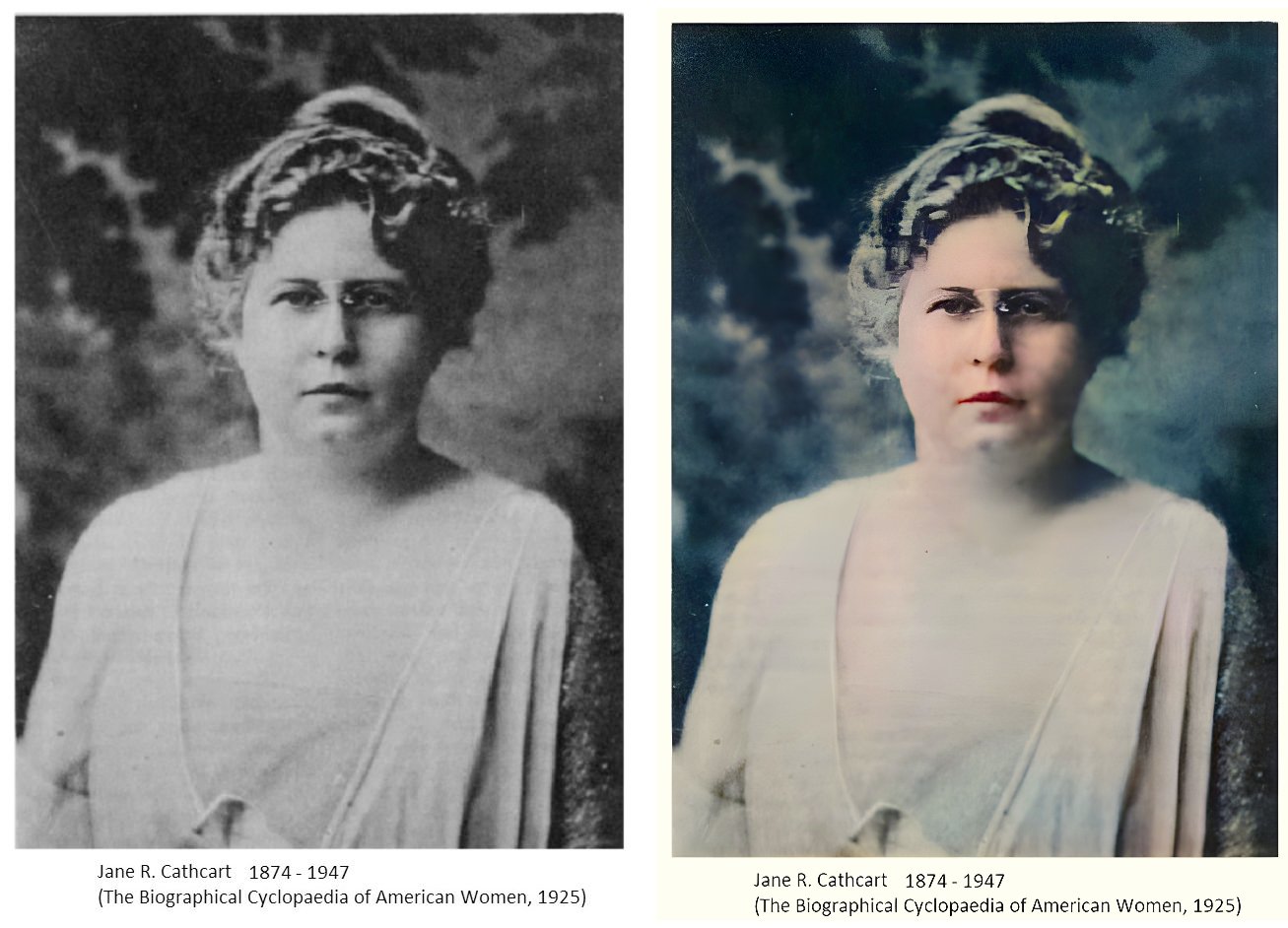
PROMINENT EARLY FANCIERS - JANE RHETT CATHCART (1874 - 1947)
Miss Jane R Cathcart, of "The Black Shorthaired Cattery," was responsible for encouraging the breeding of shorthairs in the early 1900s in North America. She imported many cats from Britain and Europe to develop and popularise shorthairs in the USA. The Detroit Free Press, 7th January 1907 referred to Jane Cathcart as "the most noted cattist in the world." Around 1916 she gave up cats completely and after a few years breeding hackney horses, all her energy was directed towards music. The Biographical Cyclopaedia of American Women (1925) listed her as a songwriter and composer. According to the Zoological Society Bulletin Vol. XVI. No. 55 (January, 1913) Miss J. R. Cathcart was a contributor to the Wild Life Protection Fund ($10)

Born in 1874, she was the daughter of George Rhett Cathcart (1843-1892), of New York City, General Manager of the American Book Company. Her father was born in South Carolina and became well known through the USA. He spent most of the American Civil War in England pursuing literary and legal studies. He later became an editor with the Daily News (Charleston), leaving in 1868 to become proprietor of The American Publisher and Bookseller (a monthly journal). He left the Daily News because his sentiments were too radical for its conservative readership. He was also editorially connected with the New York Times and the Springfield Republican. The American Book Company was an amalgamation of several publishers, including Ivison, Blakeman & Co (Cathcart became a partner of that company in 1881). It published affordable school books. The Cathcart town residence was 11 East 54th Street, NY, close to fashionable Fifth Avenue. George Cathcart died suddenly of heart failure at the family's estate in Newport, R.I. on 27th June, 1892, aged 49. His obituary in the Publishers Weekly, Volume 42, July 2, 1892 tells us that Jane was his only child. Jane R. Cathcart was 18 years old when her father died.
Jane Cathcart's mother, Jennie (1846 -1894), is always referred to as "Mrs. Geo Cathcart." According to the obituary (Times Union, NY, 29th June 1892), in 1866 George R Cathcart married a daughter of Prof James J. Mapes (1806-1866), the New Jersey agriculturalist/scientist. But which one? According to Biographical and genealogical history of the city of Newark and Essex County, N.J. (1898), the Mapes daughters were Mary Elizabeth Mapes Dodge (1831-1905), Sophia Gertrude Mapes Tolles (1831-1899), and Catherine T. Bunnell (1843-1918) - none were named Jennie (or Jane). The Mapes girls were home-educated and clever. As well as the usual subjects, they studied French, drawing, music, and Latin. Mrs Mary Mapes Dodge founded and edited "St. Nicholas" magazine for children; Cathcart answered questions about cats in this magazine.
According to The New York Times, 24th November 1894, in the "Died" column: "Cathcart. At her residence, 11 East 54th St., Nov. 23, Jane M., widow of George R. Cathcart." Only a few months earlier, The Transatlantic Travellers column of The New York Tribune (28th July 1894) had listed Mrs George R Cathcart and Miss Jennie R Cathcart as passengers on the Cunard steamer Lucania bound for Liverpool.
Jane R Cathcart's love of cats began in France when her French Poodle, Black, brought a stray cat home which she named Tiger. Back in the USA she relocated her cats to Oradell Stock Farm in Oradell, New Jersey in 1904 and named her cattery "Black's Shorthair Cattery" in honour of the Cat-rescuing Poodle. Later on, it became "The Black Short-Hair Cattery". According to The Washington Post, 1st October 1905, and Pittsburgh Daily Post of the same date, Tiger longed for feline companions, so Miss bought one and then several shorthairs, and the cats all frolicked about, to Black's delight.

Her address in Paris in 1904 was Chateau d'Epluches, pres Pontoise, Seine-et-Oise (New York Herald, European Edn, 15th October 1904)
THE BLACK SHORT-HAIRED CATTERY AT ORADELL
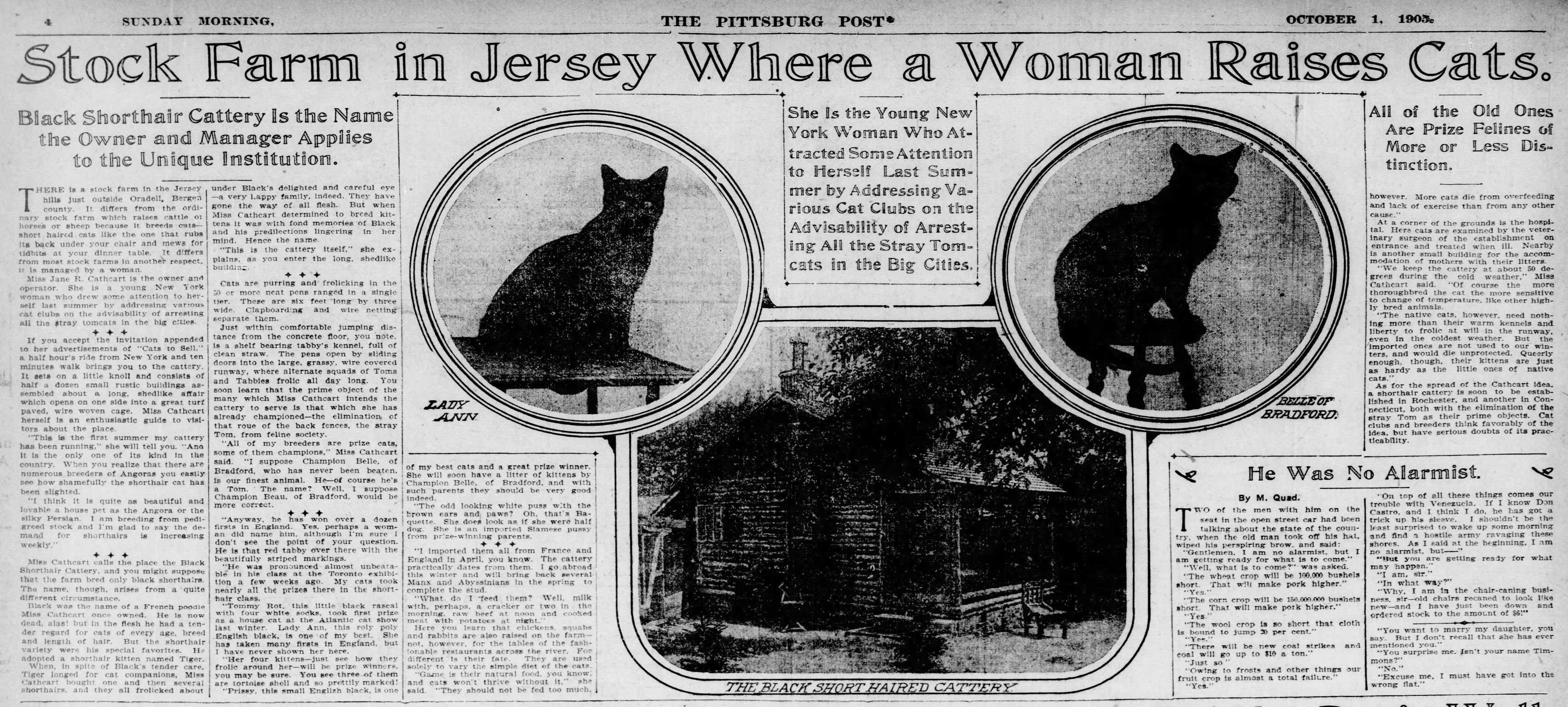
A CATTERY FOR BLACK CATS. THE UNIQUE CHARITY OF A WEALTHY YOUNG WOMAN IN NEW JERSEY. The Kansas City Star, 17th September 1904.
Miss Cathcart's Luxurious $3,000 Country Home for Friendless Felines Provides Its Inmates With a Course Dinner Each Day. From the New York World.
Over in Oradell, N.J., there has just been established a unique enterprise, on a charitable basis, called "The Black Short-Hair Cattery." Strange to say, a woman, and moreover, a young woman, is the promoter of this enterprise. Miss Josephine [Jane] R. Cathcart is possessed of youth - she is 26 years old - more than the ordinary share of good looks and decidedly more than the average portion of this world's goods.
Whether or not there is anything in the influence of names, Miss Cathcart has certainly always found her sympathies inclining strongly toward the protection and care of cats. At various tomes pet tabbies belonging to her have taken prizes at the cat shows. From association with connoisseurs, she learned that black, short-haired cats are the ones for which there is the greatest demand, and which, consequently, bring the highest prices. The desolate condition of street cats and domestic tabbies left to shift for themselves during the owner's absence from town also appealed to her. In view of these considerations the idea finally took shape in her brain of establishing an ideal home for cats where pets can be boarded at any time that their owners wish to go away, where a high grade of cats can be bred for sale, and, also, where a home is always in readiness for friendless felines. Her establishment is the first of the kind in this country.
Miss Cathcart spends much of her time traveling abroad, yet has never felt that she cared to dispose of three of the horses belonging to her family, so for some time she has boarded them at the Oradell Stock farm, belonging to John Lozier, in Oradell, N.J. Here Miss Cathcart keeps Bobolink, a horse now 37 years old, and an old family pet before the young woman was born. For the last twelve years Bobolink has done no work of any kind. He is kept in fine condition, grazes to his heart's content and never had harness placed upon him. David and Jonathan, two fine carriage horses, are also kept at the stock farm. In visiting her pets Miss Cathcart notices the beautiful location of the farm, situated as it is on rolling hills with plenty of pure spring water, most invigorating atmosphere and within one hour's ride of the city. This, she thought, would be an ideal place to start the cattery which she had long had in mind. So this summer an acre of ground was staked off, a rustic cottage, kennels and yards built, a keeper placed in charge, twelve cats installed, and behold! on August 10 the Black Short-Hair Cattery became an established fact.
The day following the successful completion of her plans Miss Cathcart sailed for Europe for an extended sojourn, leaving funds and a competent keeper - under the supervision of Mr. Lozier - to carry on the enterprise. Constant information is to be sent to the founder of the institution concerning the success of her project and the welfare of her charges. Next summer it is said that Miss Cathcart will make a flying visit to America to personally oversee the condition of the cattery.
Few cats are fortunate enough to have the care bestowed upon these favored animals. It is said that about $3,000 has already been expended upon the outfit. A charming rustic cottage of cedar logs has been built, which will serve both as an office and an indoor home for some of the cats during the winter time. In front is the office; back of it is a sort of closet with shelves running around the walls and windows opening outdoors and into the kennels behind. This closet is for the use of the cats, particularly young kittens, during the winter. Ten large, roomy kennels are at the back, opening on a good-sized yard, which is filled with delightful long grass, catnip and other growing things dear to the cattish heart. The front of the kennels is screened with wire netting, provided with a door, which is kept closed when it is desirable to confine some of the cats within.
In the winter the front of the kennels will be inclosed with glass doors, making cozy little sun parlors of the compartments. Further heat will be admitted by the door at the end of the row of kennels leading into the cottage which will be warmed by oil stoves. A long shelf runs under the eaves through the kennels for Mrs. Pussy's accommodation, so that she will not miss her accustomed promenades on fences and other places higher up. Boxes filled with clean, fresh hay furnish comfortable beds, and a contrivance which looks like and inverted wheelbarrow furnishes a luxurious nest for the kittens.
In one of the yards there is a perfectly built little house, about four feet high, which was once a doll's house belonging to Miss Cathcart. Now it is the favorite habitation of the kittens, who race up and down the stairs, peer from the windows and own the place generally. In the fall some of these kittens are to be exhibited at the cat show.
The yard into which the kennels open is surrounded with a high wire netting fence, and over the top there is also a wire netting, which effectually prevents agile cats from escaping boundaries. Beyond the cats' promenade ground there is another yard, which, when finished, is to be provided with a fountain, flower beds and well-kept lawns, apparently for the sole edification of the cats. At the upper end of the garden there is another and smaller rustic cottage, which is fitted out as a hospital for ailing pussies. A covered runway connects the hospital with the garden. In sole charge of the cattery is young George Banta, the 16-year-old son of the keeper of the stables. George is likewise devoted to animals and takes much pride and pleasure in caring for his charges.
"They are brought up on strictly scientific principles according to Miss Cathcart's orders," he said. "In the morning at about 7 o'clock they are given a breakfast of oatmeal and milk, or some other cereal. During the day I see that a good supply of fresh water is kept constantly in the kennels. No other food is given the cats until 6 o'clock in the evening, when they have dinner. This consists of vegetable soup, meat with gravy, sometimes eggs, bread and milk. Pretty good fare, isn't it? But Miss Cathcart wants it so.
"Once a week I wash the cats with antiseptics and water. Their quarters at all times are kept scrupulously clean. Our boarders pay a dollar a week, and I guess they get the worth of it. Miss Cathcart wants to get a lot of cats in fine trim for sale and also to exhibit at the cat shows. Streak has already taken a prize."
Young George Banta's little sister Isabel furnishes capable and voluntary assistance in the care of the cats. "We all love Miss Cathcart," she said, "She sends us letters with cat pictures at the top."
In George's care is also a dog belonging to Miss Cathcart. His name is Puppy. He is very knowing, but he is of no particular breed - just plain "yaller dog" - and it is strongly suspected that his mistress picked him up somewhere on the streets and brought him out to this pleasant home.
It is not supposed, nor evidently intended by a projector, that the cattery will become a paying institution. Any friendly cat with a clean bill of health or the prospect of obtaining one after medical treatment can find a comfortable home in the Cathcart Cattery. Among the rules of the establishment is one that the cats shall be conducted to their destination by agents of the cattery, "thus avoiding the nervous strain of traveling alone. The cattery will receive them for board free of charge at any time the owners may desire within five years from date of purchase. In case of illness, however, the owner will be charged with cost of medicine and professional attendance."
Cathcart did not actually live at the Oradell Farm where the Black Short Haired Cattery was situated. Her main home when she was in the USA was in Hasbrouck Heights, N.J.. about 9 miles away. She spent around half the year in France, returning to the USA during the warmer months, and had a cattery there as well. Because of the amount of time she spent away from home, she employed other fanciers to exhibit her cats. She also brought back British and European-bred cats requested by other fanciers for their own catteries.
EXPENSIVE HOBBY OF A MILLIONAIRESS - The Toronto Daily Star, 2nd September 1905. Pg 17
Quite an original brand of philanthropy is that practiced by Miss J. R. Cathcart of Oradell, New Jersey, an exhibitor at the cat show, who is possessed of a comfortable fortune of several millions. and spends much of the money and a goodly portion of her time in seeking lost and friendless cats and making them comfortable and at home. This is Miss Cathcart's hobby, and she is quite enthusiastic over it. The popular conception of a woman who is interested in cats is that she is old-maidenish and a crank, but Miss Cathcart is neither. She is young, and although not pretty, she is passably good-looking, and has a most pleasing disposition. Nobody could guess by either her appearance or conversation that she was a millionaire.
For the past few years the great aim of Miss Cathcart's life has been to help homeless cats of the short-haired variety. Perhaps she chose this class of cats because they were more numerous. Whatever her reason was, the millionaire young woman set about her work and established catteries in London, England, and Paris, France, besides the place she has at her home in New Jersey. At any of these catteries a cast-out or vagrant cat is welcome and taken good care of. Miss Cathcart's aim is to improve the breed of the short-hairs, and by good care and attention she thinks she can accomplish her purpose.
It costs this kind-hearted young woman $6,000 per year to keep the cats in her establishments. and her trip to Toronto to exhibit fifteen pets here cost $350. She chartered a special car for the purpose, and had it fitted up in a most complete manner for the feline travelers. It is certain that Miss Cathcart did not come to Toronto to win prizes for the prizes' sake. She is after the glory that there is in it. Having found that traveling in a railway car, with all its jolting and shaking, jars the nerves of the little animals. Miss Cathcart has hit on the novel plan of using an automobile to convey the prize-winners from one fair to another, until the tour is completed. This auto is now in course of construction at her New Jersey home. It will cost $6,500, and will be a very large one. Special room and accommodation will be provided for the cats, and it will have the advantage of being easily stopped at any time in case of a cat becoming ill. Two attendants will travel with the pets, and a chauffeur will be engaged for the machine.
Miss Cathcart is the owner of many valuable cats, and recently bought a handsome female, the Belle of Bradford, in England, for the moderate sum of £100 [actually Bell of Bradford, a stud cat].
Her Toronto friends treated her to a tally-ho ride around the city yesterday, and Miss Cathcart was delighted with what she saw. "Toronto is a beautiful city, and I'm coming back to exhibit here again." She said smilingly after she returned.
Miss Cathcart is accompanied on her travels by her secretary, who looks after the cats, and has also a lady companion.
Throughout the existence of the cattery, Cathcart placed numerous adverts in pet or cat magazines. She also published and distributed several editions of a booklet called "The Black Short Haired Cattery." One of her innovations was her illustrated price list printed on glossy paper (the high quality photos were even suitable for framing!) The booklet could be obtained on requested and was frequently updated. It was a glossy catalogue of her cats to help breeders select cats or select a stud cat to send their females to. Her booklets were sometimes used by the press as a source of information about the novelty of a cat-farm run by a woman. Because her father had been in the publishing business she likely had contacts able to print these booklets.
She promoted the Shorthair as being equally worth of attention as the fancier breeds. To that end she advertised for "Agents wanted to sell on commission," her intention being to set up others whose sole goal would be to breed Shorthairs. She also knew how to publicise the cattery and attract visitors, even those who were simply curious about the establishment. Its attractive grounds became a tourist attraction in New Jersey. Its publications said that visitors could have Luncheon or Afternoon Tea at reasonable rates.
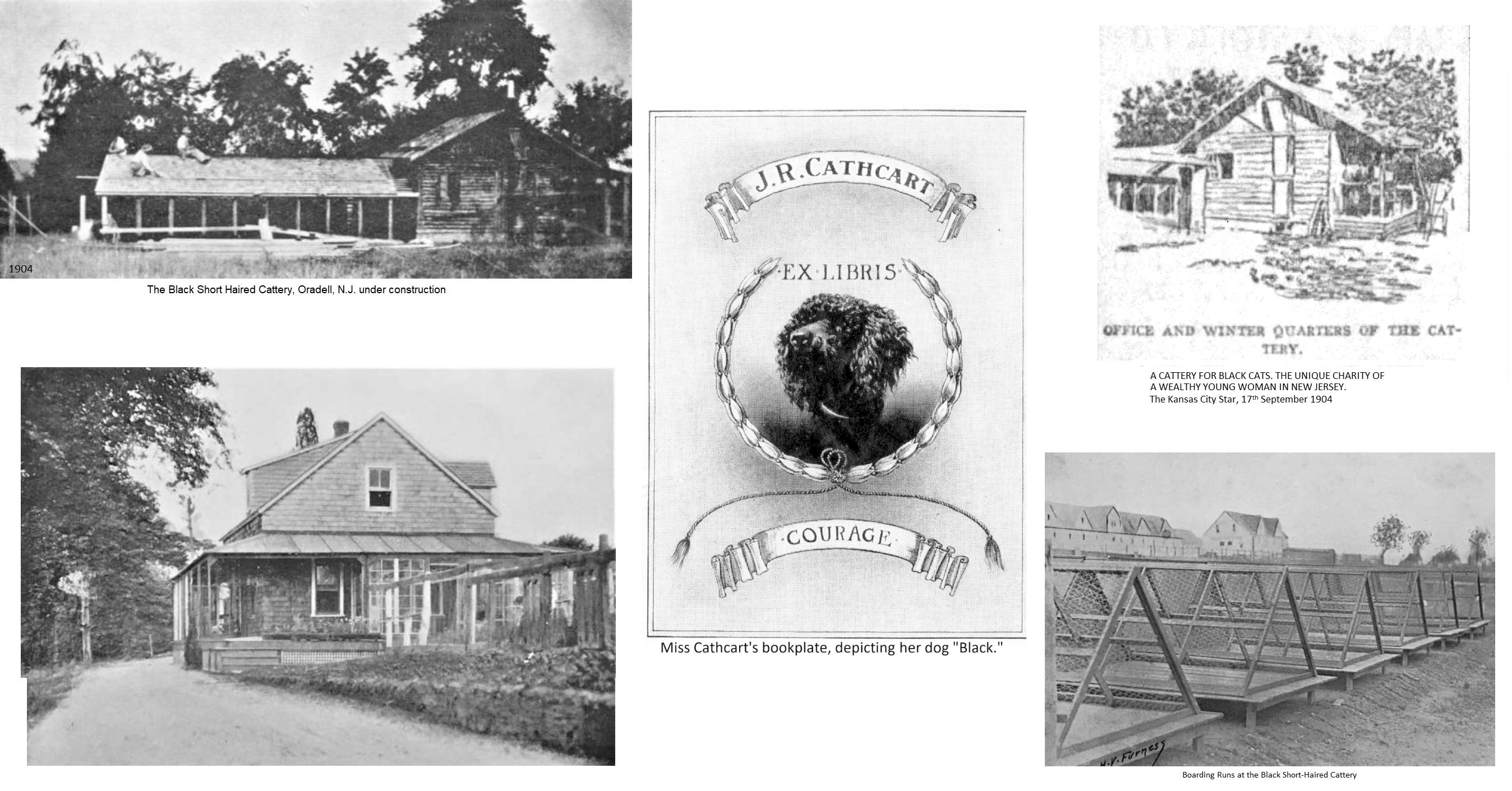
THE SHORTHAIRED CAT NO LONGER SLIGHTED. The Washington Post, 1st October 1905.
(A slightly different version of the same article also appears in Pittsburgh Daily Post of the same date.)
There is a stock farm in Bergen County, N. J., that differs from the ordinary stock farm which raises cattle or horses or sheep, because it breeds cats - shorthaired cats like the one that rubs its back under your chair and mews for tid-bits at your dinner table. It differs from most stock farms in another respect, it is managed by a woman. Miss Jane R. Cathcart is the owner and operator. She is a young woman who drew some attention to herself last summer by addressing various cat clubs on the advisability of arresting all the stray tomcats in the big cities.
The cattery sits on a little knoll, and consists of half a dozen small rustic buildings assembled about a long, shed-like affair which opens on one side into a great turf-paved, wire woven cage. Miss Cathcart herself is an enthusiastic guide to visitors about the place.
"This is the first summer my cattery has been running,'' she will tell you. And it is the only one of its kind in the country. When you realize that there are numerous breeders of Angoras you easily see how shamefully the shorthair cat has been slighted. I think it is quite as beautiful and lovable a house pet as the Angora or the silky Persian. I am breeding from pedigreed stock. and I'm glad to say the demand for shorthairs is increasing weekly."
Miss Cathcart calls the place the Black Shorthair Cattery, and you might suppose that the farm bred only black shorthairs. The name, though, arises from a quite different circumstance. Black was the name of a French poodle. Miss Cathcart once owned He is now dead, alas! but in the flesh he had a tender regard for cats of every age, breed, and length of hair. But the shorthair variety were his special favorites, He adopted a shorthair kitten named Tiger. When, in spite of Black's tender care, Tiger longed for cat companions, Miss Cathcart bought one and then several shorthairs, and they all frolicked about under Black's delighted and careful eye - a very happy family, indeed. They have gone the way of all flesh. But when Miss Cathcart determined to breed kittens it was with fond memories of Black and his predilections lingering in her mind. Hence the name.
"This is the cattery itself," she explains, as you enter the long, shed-like building.
Cats are purring and frolicking in the fifty or more neat pens ranged in a single tier. These are six feet long by three wide. Clapboarding and wire netting separate them. Just within comfortable jumping distance from the concrete floor, you note, is a shelf bearing tabby's kennel, full of clean straw. The pens open by sliding doors into the large, grassy, wire-covered runway, where alternate squads of toms and tabbies frolic all day long. You soon learn that the prime object of the many which Miss Cathcart intends the cattery to serve is that which she has already championed - the elimination of that roue of the back fences, the stray tom, from feline society.
"All of my breeders are prize cats, some of them champions,'' Miss Cathcart said. "I suppose Champion Belle of Bradford, who has never been beaten, is our finest animal. He - of course, he's a tom. The name? Well, I suppose Champion Beau of Bradford would be more correct. Anyway, he has won over a dozen firsts in England. Yes, perhaps a woman did name him, although I'm sure I don't see the point of your question. He is that red tabby over there with the beautifully striped markings. He was pronounced almost unbeatable in his class at the Toronto exhibition a few weeks ago. My cats took nearly all the prizes there in the shorthair class.
"Tommy Rot, this little black rascal with four white socks, took first prize as a house cat at the Atlantic Cat Show last winter. Lady Ann, this rolypoly English black, is one of my best. She has taken many firsts in England, but I have never shown her here. Her four kittens - just see how they frolic around her - will be prize winners, you may be sure. You see, three of them are tortoise shell, and so prettily marked!
"Prissy, this small English black, is one of my best cats and a great prize winner. She will soon have a litter of kittens by Champion Belle of Bradford, and with such parents they should be very good indeed. The odd-looking white puss with the brown ears and paws? Oh, that's Baquette. She does lack as if she were half dog. She is an imported Siamese pussy from prize-winning parents.
"I imported them all from France and England in April, you know. The cattery practically dates from then. I go abroad this winter and will bring back several Manx and Abyssinians in the spring to complete the stud. What do l feed them? Well, milk with perhaps a cracker or two in the morning, raw beef at noon, and cooked meat with potatoes at night."
Here you learn that chickens, squabs, and rabbits are also raised on the farm - not, however, for the tables of the fashionable restaurants across the river. For different is their fate. They are used solely to vary the simple diet of the cats.
"Game is their natural food, you know, and cats won't thrive without it," she said. "They should not be fed too much, however. More cats die from overfeeding and lack of exercise than from any other cause."
At a corner of. the grounds is the hospital. Here cats are examined by the veterinary surgeon of the establishment on entrance and treated when ill. Nearby is another small building for the accommodation of mothers with their litters.
"We keep the cattery about 50 degrees [Fahrenheit] during the cold weather," Miss Cathcart said "Of course, the more thoroughbred the cat the more sensitive to change of temperature, like other highly bred animals."
"The native cats, however, need nothing more than their warm kennels and liberty to frolic at will in the runway, even in the coldest weather. But the imported ones are not used to our winters, and would die unprotected. Queerly enough, though, their kittens are just as hardy as the little one of native cats."
As for the spread of the Cathcart idea, a short-hair cattery is soon to be established in Rochester, and another in Connecticut, both with the elimination of the stray Tom as their prime objects. Cat clubs and breeders think favorably of the idea, but have serious doubts of its practicability.
What was this plan regarding the eliminated of stray tomcats? This article from the (Rochester) Democrat and Chronicle explains it. She was in favour of licensing and registering cats and making ownership of [intact] tomcats illegal unless a person was a registered breeder. As The Buffalo Commercial (9th December 1909) later described it "Miss Jane Cathcart, of Oradell, N. J., . . enjoys the distinction of having originated the plan for exterminating stray cats by compulsory registration of all males. There is a horrible suggestiveness in this Malthusian, or should we say Maltesian, scheme calculated to make all men-folk sit up and take notice - and stay in nights, too."
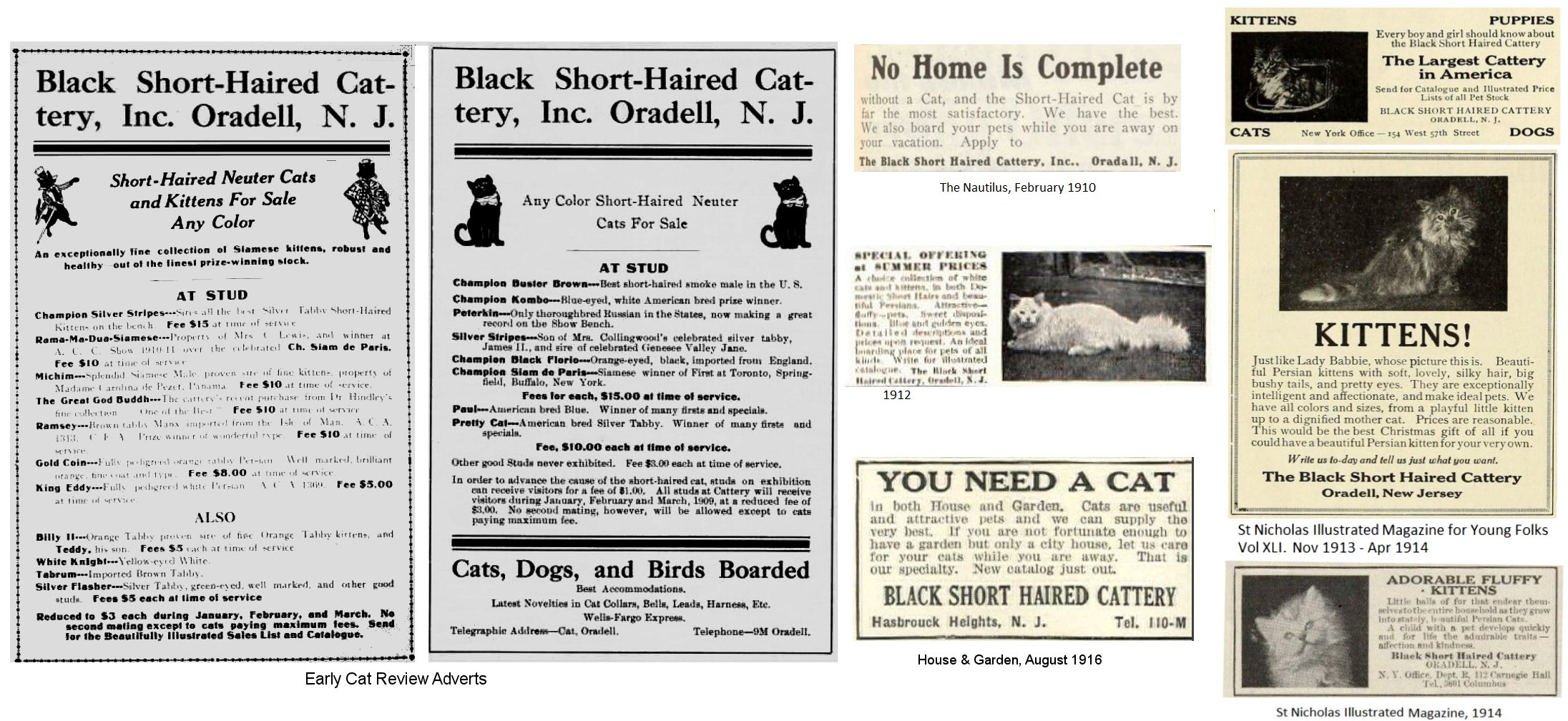
TO ELIMINATE THE STRAY CAT. PLAN PROPOSED BY YOUNG WOMAN CAT FANCIER Democrat and Chronicle, 12th July, 1905
If a plan suggested by Miss Jane R. Cathcart, of Oradell, N.J., to exterminate the tramp cat is put into operation, Thomas will find his career as a prowler abruptly terminated. Miss Cathcart is a young woman of large means who owns the only stock farm in America devoted entirely to the breeding of short-haired cats. Despite the prevailing fad for Angoras, Persians and other varieties of long haired cats, she declares that she is interested in them only as she is a lover of all animals; that she is primarily interested in short haired cats and is the "champion of the stray cat, because he needs friends most." A talk by Miss Cathcart, who is visiting in Rochester, was the feature of a meeting or the Lockehaven Cat Club held yesterday afternoon at the home of the president, Mrs, Alfred Jackson, in Meigs street. Miss Cathcart is a member of the club. In substance she said:
"Humane societies in the large cities of the country are picking up stray cats in the streets. Cats multiply at the rate of four to every pair. The number that humane societies are able to care for or destroy can have but little effect on the increase so long as both sexes of cat are allowed to run the streets. I come here as a sower of seed. The proposition I have to make is elementary in the extreme. It would rest with the club if it should take up my suggestion, to find the ways and means to carry it out. What I want to propose Is this: That one organisation in each city obtain legal control of all the cats in the town. I suggest that this organization make the ownership of tom cats illegal except In the case of breeders, who would carefully guard them. I suggest that the breeders be licensed and be obliged to pay for their licenses, the money going to the organization having charge of the cats in the city, and that the organization issue a register of the names of the breeders licensed. I also propose that the organization have the authority to confiscate male cats found running at large and keep them a certain length of time in which they may be redeemed by the owners on payment of a fee."
Miss Cathcart is having an automobile built expressly for carrying her cats and her manager from one city to another where shows are held. The auto will accommodate sixteen cats. She will exhibit eight or ten of her own in the shows the coming season, entering them in every show that is to take place after September 1st. She says the remaining six or eight cages in her automobile may be rented by persons wishing to send cats to the shows. One cage, at least, was spoken for at the meeting yesterday. Miss Cathcart owns a cattery in England and one In France. She also has in France a kennel for a pure breed of black poodles. She has brought some valuable short-haired cats from Europe to her farm in New Jersey. She says she has "cats with long prize lists and no pedigrees and cats with both prize lists and long pedigrees." Among her famous pets are Champion Belle Bradford, an orange tabby that came from England; Pressie and Lady Ann. both black; Moumouette, a blue tortoise[shell], from France, and Buster Brown, an American smoke cat. Since coming to Rochester Miss Cathcart has purchased of Mrs. Mary S. Sage Raffles and Pollypop. Miss Cathcart has been the guest for a few days of Mrs. Brace. To-day she goes to the home of the Misses Van Voorhis.
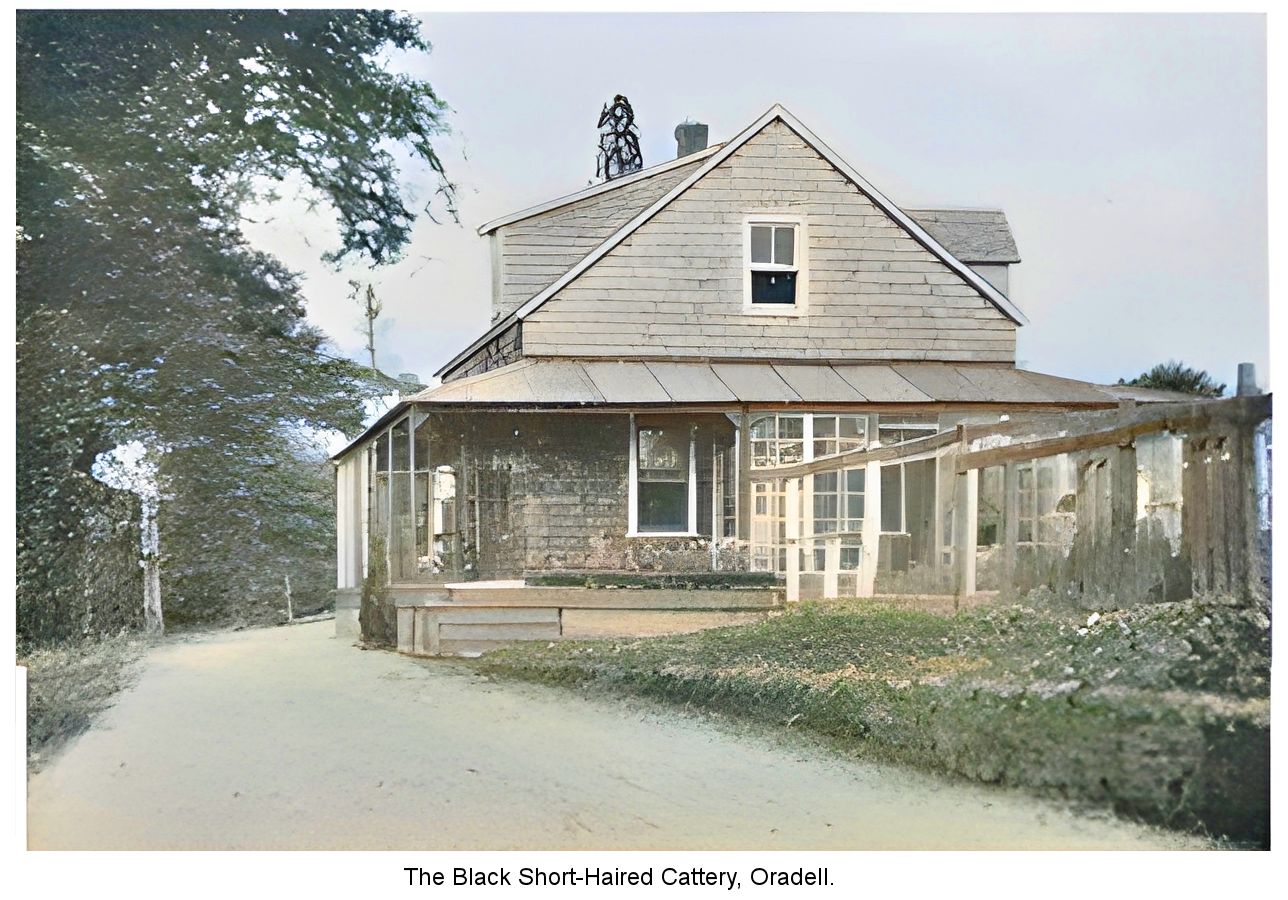
CATS ARE RISING SOCIALLY. MISS CATHCART REPORTS PROGRESS IN HER MISSION The Sun, 14th October 1905
Her Wish is to Elevate the Status of the Short Haired Cat - She Thinks People are Coming to Recognise its Real Value as House Pet - Cattery Notes.
Miss Cathcart, who has started a cattery out in New Jersey, with the aim of raising the status of the short haired cat until its ownership is limited to responsible people who will care for it properly, thus reducing the number of vagabond, homeless cats, thinks she is making progress in her mission. Last summer the cattery consisted of two small kennels and a few inmates, This season more than ninety cats, come of them champions from abroad, worth several hundred dollars each, have been enjoying its comforts.
There are winter and summer kennels, grass runs, furnished with roosts, ladders and various contrivances for feline exercise and amusement, sun parlors and infirmaries. A cow is kept to provide the cats with milk, Belgian hare are raised exclusively to serve them with food, and chickens to supply them with both eggs and meet.
"I do not want any one to suppose that this is a philanthropy," said Miss Cathcart. "Though it originated in a desire to improve the condition of the short haired cat, it would simply tend to degrade them if it were conducted on any other than business principles. I do not believe in giving a cat or a kitten to any one. A person who cannot pay at least $1 for a kitten cannot afford to have a veterinarian for it when it is sick, nor care for it property at all.
"Moreover, well to do people place no value on cats they do not have to pay for, and so a great number are turned out on the streets as strays each summer by people rich enough to close their town houses and go on vacations. The Persian cat is highly esteemed, but merely because of the price which must be given for it. lt is not hard to educate the true cat lover to appreciate the difference between the cat worth $25 and that which may be had for the taking. There is always a demand for pretty kittens. A handsome prize winning house cat is worth about $25. A champion king or queen may command several hundreds. This summer the cattery has paid its running expenses, and that I consider very good, considering how new the work is.
"If the short haired cat brings less money, it has the advantage, for the ordinary family, of being hardier and more easily trained than the Persian. Then it looks handsome the year through, while the long haired beauty loses its coat terribly in spring and fall. Some people also prefer the short hair because the mobility of its form is visible, while that of the other is hidden beneath a mass of fur."
At first it was intended to devote the cattery to producing a perfect breed of black, short haired cats only, that being a creature at present almost impossible to find. But there is yet no strain of black cat so true that kittens of other colors will not appear in each family, so the scope had to be broadened, and now the kennels hold prize winners of all colors. The black cate, however, are Miss Cathcart's chief pride, and one of these, Prissy, is considered the most perfect of her kind in existence.
"The fine black cat is coal black, and without a touch of white on it anywhere," she explained as she exhibited her treasure. "The eyes should be a deep orange, which is very hard to procure, those of most black cats being yellow. I brought Prissy from London, where I paid $150 for her."
Prissy has a broad head, round face, very small ears set far apart, and large round eyes placed straight across the face, without the slightest slant upward. These, her mistress explained, are the points which all breeders strive for in short haired cats.
The kings of the establishment occupy each his separate run and little summer cottage. Most of the kennels are like miniature Queen Anne cottages, with two stories and many doors and windows, for all cats love a place in which to hide and climb.
"The bedding in these houses must be burned and renewed every day without fail," Miss Cathcart said. "Then each cat has two houses, one being taken away after it has been in use two or three days, thoroughly disinfected, scrubbed and left to the sun and air while the other is in use. One must not economize trouble when running a cattery.
"This is Riquiqui, a royal Siamese king," unfastening the gate of a large run.
Riquiqui's sleek coat is the color of covert cloth, while his short, crooked tail, big cars, nose and legs are dark brown. His eyes might be patches of the sky, they are such a clear, turquoise blue.
"You see how crooked his tail is," said his mistress. "That is considered a very good point in a Siamese cat; so are the blue eyes. The darker the points of the Siamese the higher he ranks. The brown in Riquiqui's coat is a little light just now, but it will become darker in the winter. These cats are growing in favor here as pets among wealthy women, but they are extremely hard to raise in this climate. They are very much in vogue in Paris just now because they are odd as well as beautiful. Riquiqui came from Paris with me in the spring and his wife is to follow soon. Such a pair is worth about $75.
"And this is Buster Brown," she continued, opening another of the small runs. "He is a champion short hair smoke and a native of America."
Placed by the side of a black cat Buster's coat showed a tinge of plum color or dark cinder, though without the comparison the difference was scarcely noticeable. Unlike the black cat, however, his under fur is pure white, the hair shading gradually from white at the roots to black brown on the tips. This is the peculiarity of all smokes, which are extremely rare, and especially so in the short haired class. Buster is a champion of his kind, and has been beaten only once, and then by his wife, Judy B., for whom Miss Cathcart paid $200. Judy B. lacks the handsome, well shaped head of her mate, but excels him in the fine quality of her coat and its even upper tone; also her tail is thinner. What the English call a whip tail is desired for a short haired cat, because a thick tail, breeders say, shows a long haired ancestor.
An orange tabby king, Belle of Bradford, represented England, having won his championship in that country before coming here. He is orange even to his eyes, tiger markings of a deeper shade running through his coat. No touch of white mars his perfection.
There are few orange queens," Miss Cathcart said, "and there are no tortoise shell kings. Belle of Bradford, therefore, makes a good mate for a pretty tortoise shell queen of mine. Then, with an orange father and a dark blue mother we can get the pale blue kittens which are now so much preferred to the dark blue."
The blue cat is a native of Russia, though it is commonly called Maltese, and a very pale silver gray is the odd shade now desired in its coat.
A short hair cat society has recently been founded in Rochester. Miss Cathcart is its president and it will have branches in every city of the country. It will strive to instruct cat owners about the care and possibilities of cats. Besides exhibiting at the regular cat shows this winter it is to hold one of its own at which a special feature will be prizes of money for poor men's cats.
A municipal ordinance will soon go into effect in Rochester which will oblige any one who keeps a tomcat to pay a breeder's fee or license. This is regarded by cat lovers of that city as the most practical measure for decreasing the number of strays, which has been so great this summer as to make it impossible for the various cat homes and shelters to handle them.
"It would be impossible to have such a law in New York yet," said Miss Cathcart. "The city is too large. Even in Rochester it is merely an experiment and is likely to be modified. Later such a law might be made practicable in large cities."
In one of the large summer runs is Billy Baxter, a brown tabby and white, who is especially interesting because he exhibits what is considered perfect marking in all cats which are not solid in color. The white begins in a sharp point between the eyes, spreads over the lips, covers the chin and extends down the chest, forming a shirt front. His four feet are white. When the white extends to the legs of such a cat it must be as even as possible on all four. The eyes of all cats marked with white should be orange, no matter what the other color of the coat may be. The pure white cat, however, must have blue eyes, according to the English rules; but in this country there is a separate class for those with yellow eyes.
Among the inmates of the cattery are twenty cats in runs by themselves, and those have a history. They are the wards of a New York woman who devotes time and money to rescuing strays from the streets and keeping them at her own expense until she can find good homes for them. Among many beauties in this collection of former tramps are two remarkable, gigantic white cats.
"I have had about forty boarders this summer," said Miss Cathcart. "The care of the cat? Nothing better can be given them to eat than table scraps. I give my cats a drink of fresh milk in the early morning and after that two meals a day. Some people do not believe in milk for cats, but I do. They have raw beef and many other kinds of meat, besides the rabbits and chickens. I give them constant variety, every meal different from the last. Of vegetables of all sorts they should have an abundance; they are also fond of cereals. Raw egg is good for them, and cats are always fond of it; but it is too heating for summer diet."
"A cat should never he washed. The short hairs ought to be combed several times a week and the cats should then be rubbed with a cloth to polish their coats."
The Idaho Republican, 27th March 1908: At a cattery conducted by Miss Cathcart in New Jersey, the tenants are bred and cared for with a strict observance of all the laws of feline hygiene. The kennels, or rather houses, are of Queen Anne style of architecture and provided with doors and windows and nooks and corners to afford pussy the opportunity she so loves to looking out the parlor window or retiring to her chamber for a siesta at will. Each member of this colony is provided with two houses, and is moved from one to the other every two or three days while the first is being cleaned and renovated. The bedding in each house is removed every day and burned. The cat's toilet consists of a thorough combing followed by a rubbing with a cloth several times a week . . . Among the ninety or more inmates of this cat home are a number of blue-blooded, short-haired celebrities who have won reputations in this country and in Europe. Prissy is a black cat, without a white hair anywhere, and considered the most perfect specimen of her class to be found. She came from London, and is valued at the price of a good horse. Belle of Bradford is another Britisher, and is orange even to the color of the eyes. Requiqui is of Siamese descent, but is a native of Paris, and is dark brown with blue eyes. Buster Brown would be black if he were not tinged with a plum tint, and is what is known as a smoke.
Some of her feline boarders belonged to important owners, for example these pedigree cats belong to a diplomat's wife. "Four Siamese cats arrived here recently on the United Fruit Company's steamship Zacapa which got in from Colon and West Indian ports. They were the property of Mrs. Frederico A. Peret, wife of the Peruvian minister to Panama. Most of the voyage the cats occupied a stateroom, and a special steward was assigned to care for them. They are going to a cattery in Oradell, N.Y., consigned to Mrs. Jane Cathcart . . . The cats were made the subject of a diplomatic correspondence, for the diplomat asked the collector personally to expedite their handing so that they could get to the cattery as soon as possible. Three of the cats occupied a padded crate and the fourth, the head of the family, occupied equally comfortable quarters in another crate. When the vessel sailed out of Jamaica the crates were placed on the upper deck. When the Zacapa was one day out of that port it was discovered that the male cat had broken out of his crate and disappeared. The ship's officers believed he had been stolen in port and a wireless message was sent back notifying the agent of the escape or theft of the diplomat's cat. . . . Late in the evening the missing cat was found in the laundry and recaptured after a chase. After his escapade the crates were moved to a stateroom. The animals are said to be fine specimens of their kind. (The New York Times, 21st April 1911)"
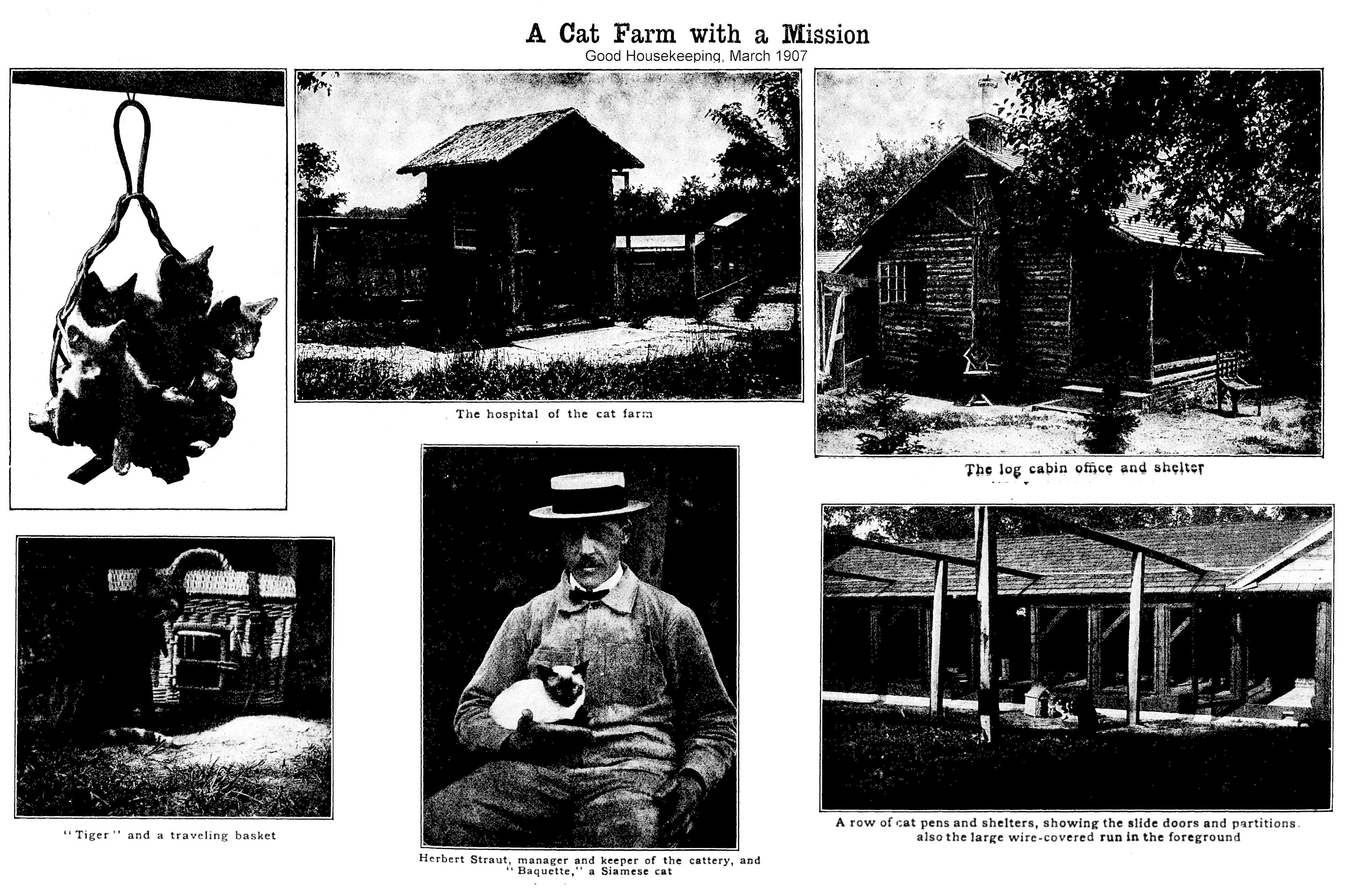
A CAT FARM WITH A MISSIONBy Joseph Henry Adams, Good Housekeeping, March 1907
A young and wealthy lady of New York, Miss Josephene R. Cathcart [should read "Jane R. Cathcart"], has established among the hills of New Jersey, in Bergen county, a luxurious cat farm - a country home and a boarding house for friendless cats, and a place for the harboring and breeding of the short-haired species from pedigree stock. Many of Miss Cathcart's best cats have taken prizes, both here and in Europe, whence many of her finest specimens have been imported.
In the "cattery," or shed where the mother cats and their litters are sheltered, pussies are purring and frolicking in fifty or more pens. These pens are six feet long by three wide and are partitioned by means of boards and wire netting. In the winter time the fronts are inclosed with glass. Within comfortable jumping distance from the concrete floor there is a shelf on which a kennel is located; this is kept clean and covered with straw on the bottom to make a comfortable resting place for the feline residents. The pens open into a large, grassy, wire-covered runway. Here catnip and other herbs are growing where they are within easy reach of the inmates. Within this runway there are roosts, ladders and other contrivances for the exercise and amusement of the animals.
The studs have their quarters apart and are not allowed liberty in the large run. Some of them are magnificent specimens, and despite their sex, most of them are very affectionate, especially to their owner, Miss Cathcart.
By reason of the healthful location and the great care exercised, sickness has been practically unknown. For the sick ones, however, there is an infirmary or hospital on the grounds where cats are placed the moment they show any signs of indisposition, and where they receive the proper medical attention from the physicians of the American veterinary hospital.
Last summer there were, in addition to the sixty or more residents, about fifty cat boarders, of the short and longhaired varieties. One of the objects of the cattery is to provide a temporary home for the pet cats of families who go out of town for the summer months. Miss Cathcart has her attendants call for and personally travel with the cats, which ride in specially constructed baskets. For this service the travelling expenses and one dollar per week are charged for short haired cats, and two dollars a week for the long haired variety, such as the Angoras, Persians and other oriental breeds.
A unique and original feature of the institution is the plan whereby an owner can insure a cat for any declared value by the payment of fifty cents a week on every five dollars. Should the cat die while at the cattery, and if the premium is paid regularly, Miss Cathcart will send her cheek to the owner for the full amount paid in, with the physician's certificate of death and the cause.
One of Miss Cathcart's many aims, which she has already championed, is the elimination of that roue of the back fences, the stray tom, from feline society. Last summer she addressed various cat clubs on the advisability of arresting all the stray tomcats in the big cities, and either neutering them or placing them under license so that a large percentage of kitten misery in cities and towns might be eliminated. As a consequence of this campaign, it is expected that catteries will be established in different parts of the country for the harboring of stray cats of good disposition and qualities instead of leaving them to the Society for the Prevention of Cruelty to Animals and the gas tank.
The owner of this cat farm is a strong advocate of the short-haired cat. "I think it quite as beautiful and lovable a house pet as the Angora or the silky Persian," says Miss Cathcart. "I am breeding from pedigree stock and I'm glad to say the demand for short-hairs is increasing continually. All of my breeders are prize cats, some of them champions. I suppose Champion Bell of Bradford is our best animal. He has won more than a dozen firsts in England and today he is without exception the finest orange colored cat in the United States. In 1906 my cats took more than one hundred prizes. This little black rascal with white socks," continued the lady, picking up a silky, short-haired animal, "is Tommy Rot. He took first prize at Atlantic City last winter as a house cat. This rolly-poly black English beauty, Lady Anne, is one of my best. She is worth nearly two hundred dollars and has taken many first prizes in England."
For kittens from pedigree stock Miss Cathcart gets from twenty-five dollars up, and for the ordinary neuter house cat from ten to twenty-five dollars, according to the disposition. No cats are sold under six months of age and all during their younger life they are harbored with other cats of good disposition, so their temper and actions are trained to a certain extent.
One of the most peculiar looking cats on the farm is the little Siamese queen, Baquette. Mr Straut, the manager and keeper at the farm, is holding her in his hand in the picture. She is snow-white, with velvety brown paws, tail, ears and nose. Her fur is like sealskin and her eyes are a pale lemon-yellow color.
The temperature of the cattery is kept at about 50 degrees Fahrenheit in the winter by the hot water heating system. Cats in normal health are fed milk with oatmeal or crackers in the morning, raw chopped beef at noon or perhaps some raw rabbit or chicken meat, and at night they always get cooked meat and potatoes; also soup, vegetables and eggs. Chickens, squabs and rabbits are raised on the farm, but not for market; they are prepared as food for the cats, whose natural food is game. Cats should not be fed too much, however; more of them die from overfeeding and lack of exercise than from any other cause.
During the day a good supply of fresh water is kept in the kennels and once a week each cat and kitten gets a bath with soap and anti-septicized water. Their quarters are kept scrupulously clean at all times.
Cats which are brought to the farm as boarders do not always become accustomed to the surroundings at first; they sometimes pine, grow thin and worry. They are put through a special course of treatment; fed on chopped raw meat and raw eggs, and the second time they are brought to the farm, it is said, they become reconciled to their surroundings at once.
When the show season opens, about August 28, the cattery sends a number of its best cats from show to show, and Miss Cathcart accompanies them with the keepers, buying and selling during the sojourn in each city, until the season closes, the last of February.
The cattery includes among its own cats a certain number of outsiders whose owners would like them to attend these shows and yet be sure of good accommodations and care en route. They are charged for at the rate of one dollar a week in excess of usual boarding rates, all expenses included, excepting entry fees and medical attendance. A first-class automobile is now being constructed for the accommodation of these cats, and those intrusted to the care of the cattery can be insured against death from any cause while traveling, at a premium of ten per cent on value, as already described in the novel and ingenious insurance feature.
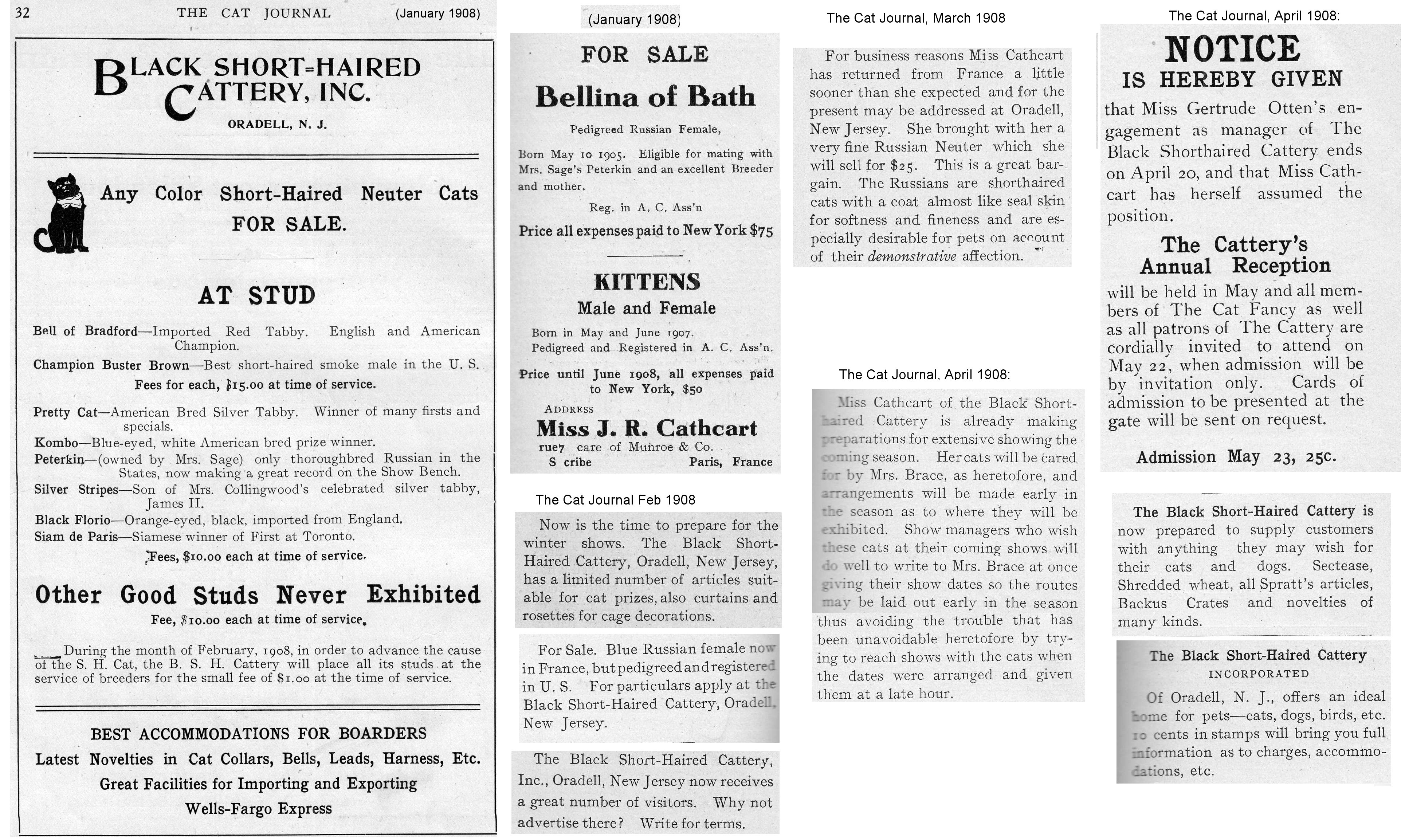
The Black Short Haired Cattery was incorporated as a company (doing "foreign business") in New York on 7th April 1909. The Black Short Haired Cattery Inc was dissolved as a company on 5th April 1910.
HEALTHFUL DIET AND ICED BATHS TOR 85 CATS AT RICH MISS CATHCART'S TABBY FARM IN JERSEY - The Evening World, New York, 6th July 1911
PET PUSSIES AT SUMMER HOME PROVIDED BY WOMAN MILLIONAIRE FARE BETTER IN HOT MONTHS, THAN BABIES IN THE TENEMENTS. GROOMED EVERY DAY, FED FROM INDIVIDUAL PLATTERS AND HEADS SPONGED, HIGH BRED ANIMALS ARE KEPT COMFORTABLE.
Do you like cats? And if you do, can you truthfully say that you like eighty-five cats all at once? That is the way in which Miss Jennie R. Cathcart [her legal name] likes cats. Miss Cathcart is the proprietor of the Black Short-Haired Cattery at Oradell, N.J., and at present there are eighty-five felines carefully housed at the cattery. Since Miss Cathcart is the reputed possessor of some millions of dollars, it is obvious that the eighty-five would not share her hospitality unless she so wished. She herself was in the Berkshires yesterday for a brief vacation, but her manager, Mrs. G.N. Strongitharm, told all about her employer's unique fad.
"It is a fad with her, nothing more," began Mrs Strongitharm, "She started with about six cats of her own five years ago. She has always been passionately fond of cats, and had two objects chiefly in view when she opened the cattery. She wanted to provide a boarding place for pet cats, where they could have, as far as possible, the comforts of home, including spacious quarters and ample opportunity for exercise. Her other idea was the breeding of high class short-haired cats.
"She began in a tiny little log cabin, on the land which is in the heart of the Oradell stock farm. That fact incidentally, assures perfect privacy. The work increased by leaps and bounds, until now we have all this," and Mrs. Strongitharm pointed to the hundred kennel-like coops for the cats, and the pretty, brown-shingled office building where she and her mother, Mrs. J. M. Martinot, live.
There is also provision for boarding a limited number of dogs, there is a nice poultry house, and this year Miss Cathcart has begun to keep pigeons. But her main interest is still cats. There are pussies by the score, black and gray and "tiger" and white angora, not to mention some extremely valuable foreign breeds. The latter Include one of the most costly cats in the country, Stiver Stripes, a big champion silver tabby valued at $1,000. Then there are several Siamese cats, white and short-haired, with queer tawny markings about the muzzle and sometimes a knobby twist to the rather short tall. And there are many kittens,
Each cat has his own quarters, which consist of a green box about the size and shape of a good-sized [dog] kennel, set in the corner of a grassy wire-fenced inclosure. In each inclosure is a wooden table tor kitty to clamber over. Wooden troughs hold his drinking water and for food – but let Mrs. Strongitharm tell about that.
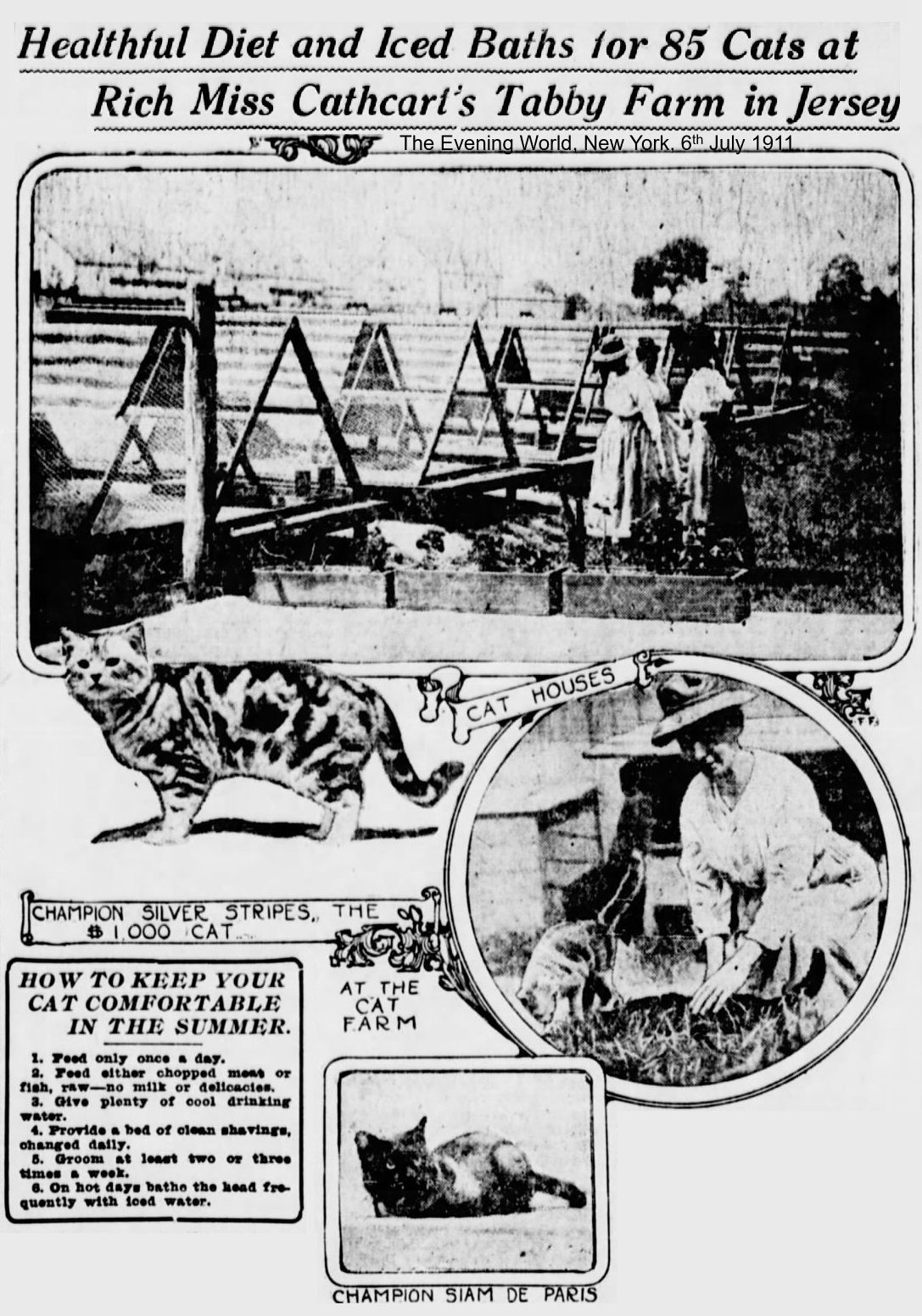
"The cats are fed just once a day," she explained, "About five o'clock in the afternoon each is given one-sixth of a pound of chopped raw beef. It is served in Individual boxes of the small wood fibre variety, and after each meal the boxes used are burned. That is, one dish serves one cat for one meal. They are given nothing else to eat and no milk to drink unless they are ill and seem to need it. Fish is given them once a week. I forgot to say that on Fridays chopped raw fish is substituted for the chopped meat - you see they are Catholic cats.
"The kittens have milk, but by the time they are two months old we begin giving them meat. When any of the Angoras get off their feed they may have an egg well beaten up. With the chopped beef we frequently mix such vegetables as canned beans or potatoes. But we think that most cats are fed too much, just as a great many people nowadays eat too much, and indigestion and other troubles result in the case of both people and cats,
"Every morning each cat is groomed. We use brushes and combs for the angoras, and a cloth resembling chamois for the short-haired cats. This keeps the coats in good condition and renders washing unnecessary. Of course, if a cat is sent to us that has been in the habit of getting a bath every week we follow the owner's instructions and bathe it. The beds are simply small, fine shavings, and are changed every day, when the houses are cleaned out. We have practically no trouble with our charges. So many people say cats are treacherous and attached to places rather than people We haven't found this true. I think it all depends on handling. Our cats are rarely saucy.
"Miss Cathcart has some beautifully bred cats of her own. The points are a short, broad head, short legs and broad body. The Siamese cat should have hue eyes and the black cat orange, or, as a next choice, green.
"One of the things Miss Cathcart particularly deplores is the heartless fashion in which families will go off for a summer vacation and leave the poor pet cat to shift for herself. What, with the heat and scanty food and small boys and dogs the life of this unfortunate animal is a sad one. She had this in mind when she opened her home, and she herself would always bring a destitute cat here rather than see it suffer. She comes out here every day when she is living at her home in Hasbrouck Heights, N.J.
"How do the cats stand this weather? They suffer from it, but we keep bathing their heads every few minutes with iced water and give them plenty to drink. That's all we can do.
"Miss Cathcart only expects the place to pay its expenses, as she loves the work for its own sake. She has scores of trophies which she has won at exhibitions. But there really is a great opportunity to make money in a cat farm if a woman should start it with that purpose in mind. It only costs $3 or $4 a month to take care of a short-haired cat, including food, and perhaps twice that amount for an angora."
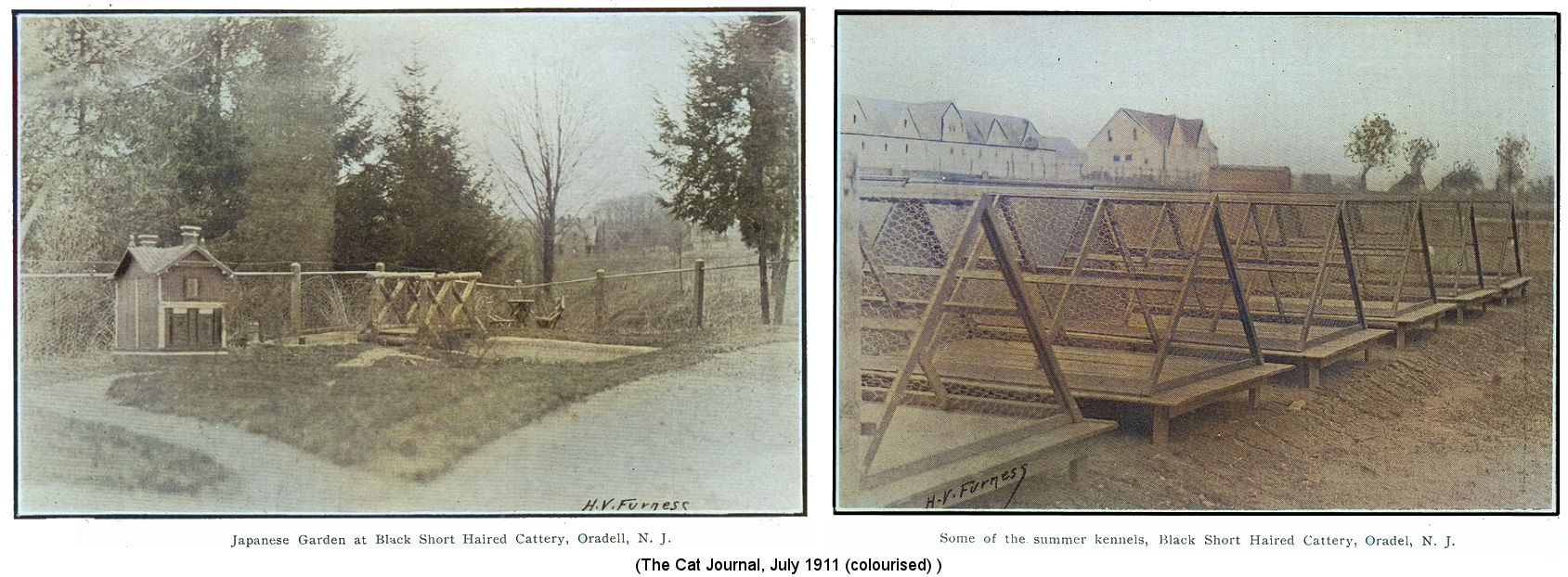
CAT AND DOG LIFE BELIES ITS NAME AT ORADELL. New York Tribune, 10th May 1914
Fido and Tom Agree to Mediate All Their Old Controversies. Tabbies Find Rest From Brain Fag. Home First Founded by Miss Cathcart to House One of Her Pets.
When one wishes to convey the idea of no harmony at all one refers to a "cat and dog" existence, but this does not include the inmates of the Black Short-Haired Cattery at Oradell, N. J. Here the felines and the canines mingle and enjoy one long holiday, and although the hostlery was originally planned as a home for pampered pussies which were suffering from brain fag, they have very generously shared their home with friend Fido, and they do not make him lead a dog's life, either. In providing places where one might board one's dogs and horses, no one seemed to consider that pussy might like a place where she could spend her vacation. It seemed to be the order of things that when the rest of the family went away for the summer the feline members of the family were supposed to forage in garbage cans for their food in the day-time and spend the evenings on the fence "making night hideous" for the neighbors. Furthermore, they were supposed to enjoy this nomadic sort of existence, although those who know them best say that cats are quite as devoted to their friends as are dogs.
Miss Jane Cathcart, who founded the cattery at Oradell did so, she says, because it was impossible to find a home for her cat when she went abroad. There was no trouble about the horses or the dogs, but nobody wanted to undertake the care of Tommaso Scatto. There was only one thing to do, and Miss Cathcart did that. She bought a small plot in the centre of a farm at Oradell, put up a portable bungalow, and hired a keeper - all for one little cat of the common, or garden, variety. Since then it has grown and grown, until now it is one of the show places of the country. So many persons owning pet cats were ready to take advantage of the chance offered them to board their pets for the summer that the second season found the quarters considerably enlarged.
It was the third season before dogs were allowed to enter - and then a prospective boarder of the genus catus refused to be separated from her friend Fido. After some discussion Fido was taken on probation, and now half of the inmates of the cattery are dogs.
Mrs. Harriett V. Furness, who has won a national reputation because she has been able to portray the character of animals with the camera, as well as with the brush, is secretary of the cattery. Every one who has anything to do with the cattery, the kennels or the inmates must love animals. That is the first requisite, and in this Miss Cathcart is indeed to be commended, for no one who does not really care for animals can be successful with them.
Mrs. Curry, who is manager of the kennels, is an animal lover in the best and truest sense of the word. She was the wife of the late Dr. W. W. Curry. All the work is done under the personal supervision of the Indefatigable manageress, and woe betide the kennel man who attempts to neglect his charge in the smallest detail.
The kennels are nothing if not artistic, some of them being regular little log cabins built to accommodate from ten to fifteen animals. The cabins consist of three rooms and sun parlor, with outdoor runs and porches. The smaller bungalows have one room and will accommodate four animals comfortably. In the trophy room are any number of ribbons, cups and prizes won by the inmates of the cattery, although not all of them belong to the feline inhabitants.
Miss Cathcart is the owner of some very fine dogs, most of which are home-breds. There are Russian wolfhounds, French poodles, Boston terriers, pointers, Airedales and, last but by no means least, cocker spaniels. Mrs. Curry has a penchant for cockers, and it has been said jokingly that, however strong minded one may be, if one journeys to Oradell to buy an Airedale one will return with a cocker or possibly two. Magistrate is at the head of the cocker family at Oradell. He is a wonderful cream and is well known on the bench as well as in the kennel. Zeka and Defender head the Russian wolfhound army, and many consider them as fine as any American breds in the country. About the best known of the French poodles is Chiquita, a black toy, with an international reputation. Chiquita is a friendly little creature and is always the last to wish one au revoir, and one leaves the beautiful park overwhelmed with the hospitality of the inmates and feeling that there are lots of things that are worse than leading a cat and dog existence.
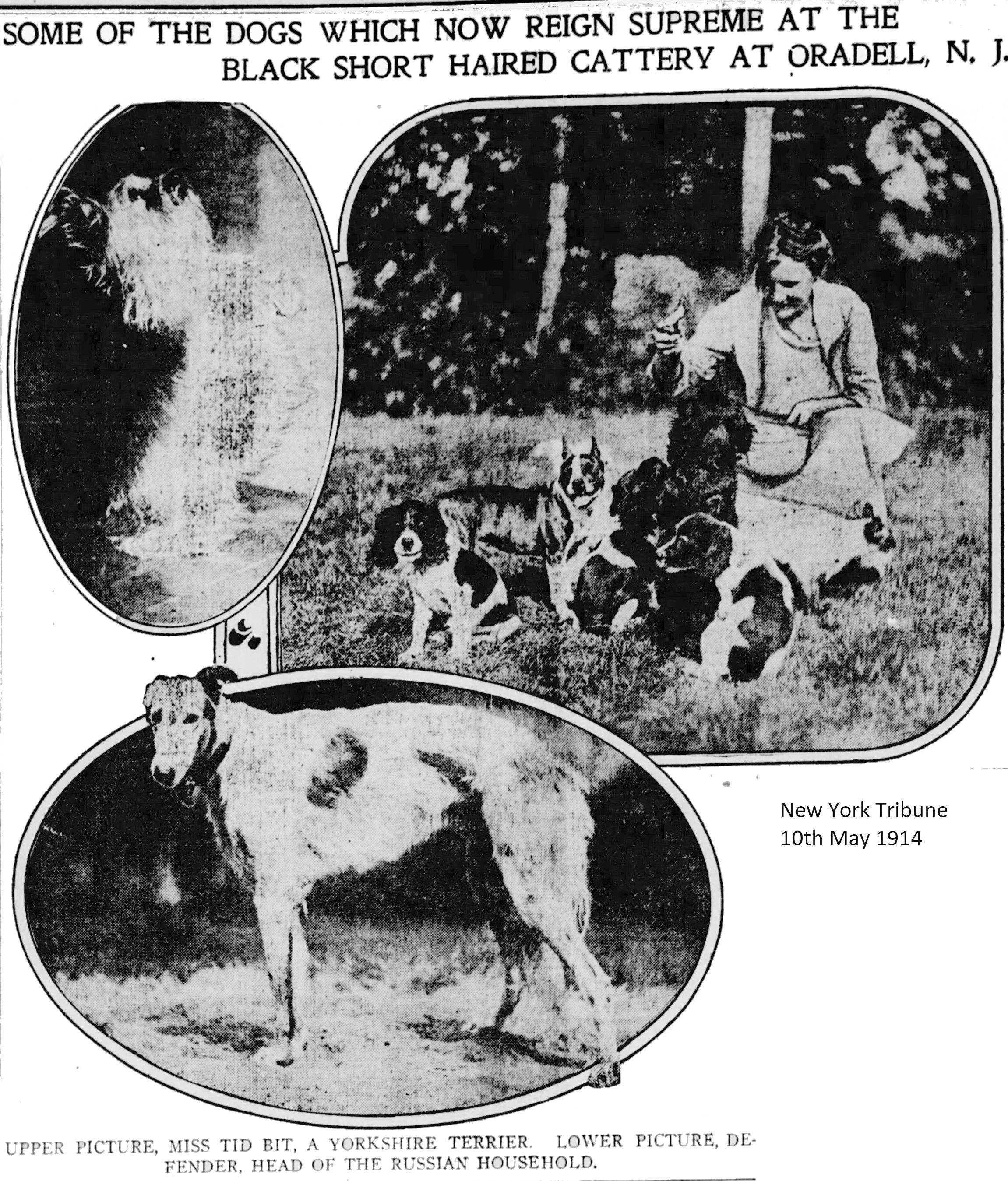
THE ROCHESTER BRANCH OF THE BLACK SHORT-HAIRED CATTERY
HOME FOR CATS LIGHTED BY GAS Democrat and Chronicle 7th February 1910
At the new home of Mrs. Elizabeth L. Brace, No. 580 Parsells avenue, recently built, there is being completed a model cattery. The largest part of this well-equipped establishment is the Rochester branch of the Black Short-Haired Cattery conducted by Miss Jane K. Cathcart, at Oradell, N. J. Miss Cathcart, a young woman of means who has catteries in both this country and France, takes "summer boarders" at the one in Oradell. She sometimes has as many as 100 of these and when her quarters are filled she sends the overflow to Mrs. Brace. This overflow is made up of Miss Cathcart's own cats, which Mrs. Brace, her manager, takes to all the shows in which they are entered. Twenty-five are here now.
[CATHCART VS. BRACE & EVANS (FORECLOSURE, SUPREME COURT)] Democrat and Chronicle, 23rd September 1912.
State of New York, Supreme Court, Monroe County. Jane R. Cathcart, plaintiff, vs. William W Brace, Elizabeth L Brace and Charles P Evans, defendants.
In pursuance of a judgment of foreclosure and sale duly granted in the above entitled action and entered in Monroe County Clerk's office on the third day of September, 1912, I, Herbert Leary, the undersigned referee in said judgment named, will sell at public auction to the highest bidder from the front vestibule of the Court House in the city of Rochester, county of Monroe and state of New York, on the 29th day of October, 1912, at 11 o'clock in the forenoon of that day, the premises described in said judgment, as follows: All that tract or parcel of land situate in the town of Brighton, county of Monroe and State of New York, known and distinguished as lot No. twenty (20) on the north side of Parsells avenue [. . .] being the same premises conveyed to said William W Brace and Elizabeth L Brace [. . .] this mortgage is made subject to the restrictions set forth in said deed. Dated at the city of Rochester, New York, this 13th day of September, 1912.
Herbert Leary, Referee.
THE BLACK SHORT-HAIRED CATTERY AT HASBROUCK HEIGHTS
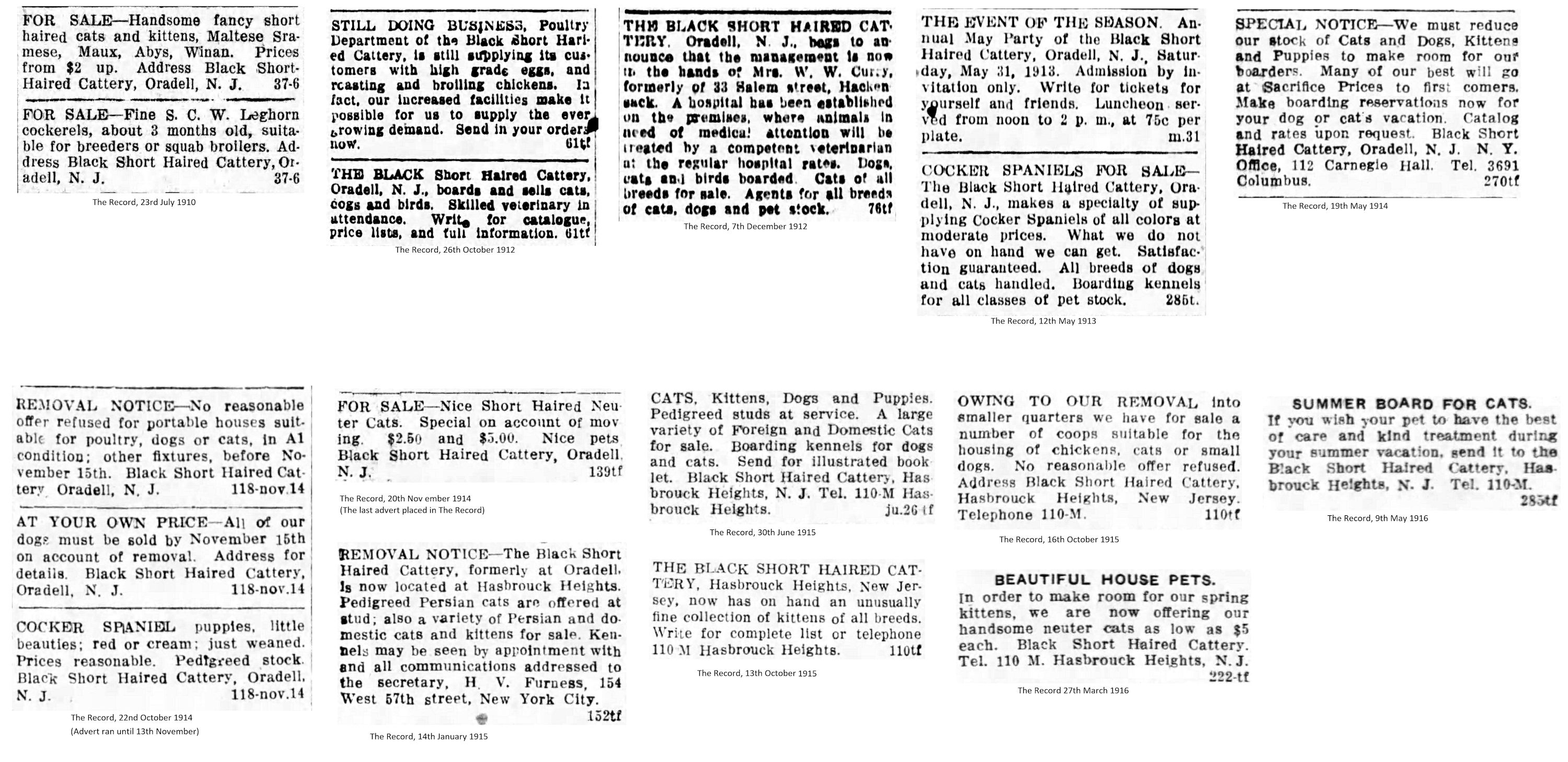
The changes to the Black Short Haired Cattery can be traced in adverts placed in The Evening Record, Hackensack, N.J. between 1912 and 1914. In October 1912 an advert stated it was "Still Doing Business," referring to its poultry department selling eggs and table fowl. It mentions the poultry business having increased facilities. At the end of 1912, management of the business was transferred to Mrs M W Curry. The emphasis was on boarding and acting as agent or intermediary to get whichever breed of cats or dogs a customer wanted, and it sometimes advertised for "dogs wanted." It specialised in Cocker Spaniels. There was little or no mention of cat breeding.
In January 1914 until mid-April 1914, it still advertised both longhair and shorthair cats at stud, but also advertised dogs at stud. By 22nd April 1914, the home-bred cats and dogs were being sold off at rock-bottom prices to make way for boarders. It also had a New York Office at 112 Carnegie Hall. The breeding business had been wound down. Until 20th October 1914, there don't seem to be any breeding cats there and even the dogs were being sold off at rock-bottom prices. On 22nd October the advert changed to say all fixtures, buildings etc had to be sold off before November 15th due to "removal." Finally, on 24th November, a few neutered pet cats were offered for low prices.
On 14th January 1915, an advert stated the Black Short Haired Cattery was now located at Hasbrouck Heights. The secretary was still H.V. Furness. By June 1915, the cattery and kennels, having relocated, were offering stud services and sales. Due to its removal to smaller quarters, a number of pens and coops were sold off. The last advert I found was October 16th 1916 for summer boarding.
THE SHORT-HAIRED CAT SOCIETY
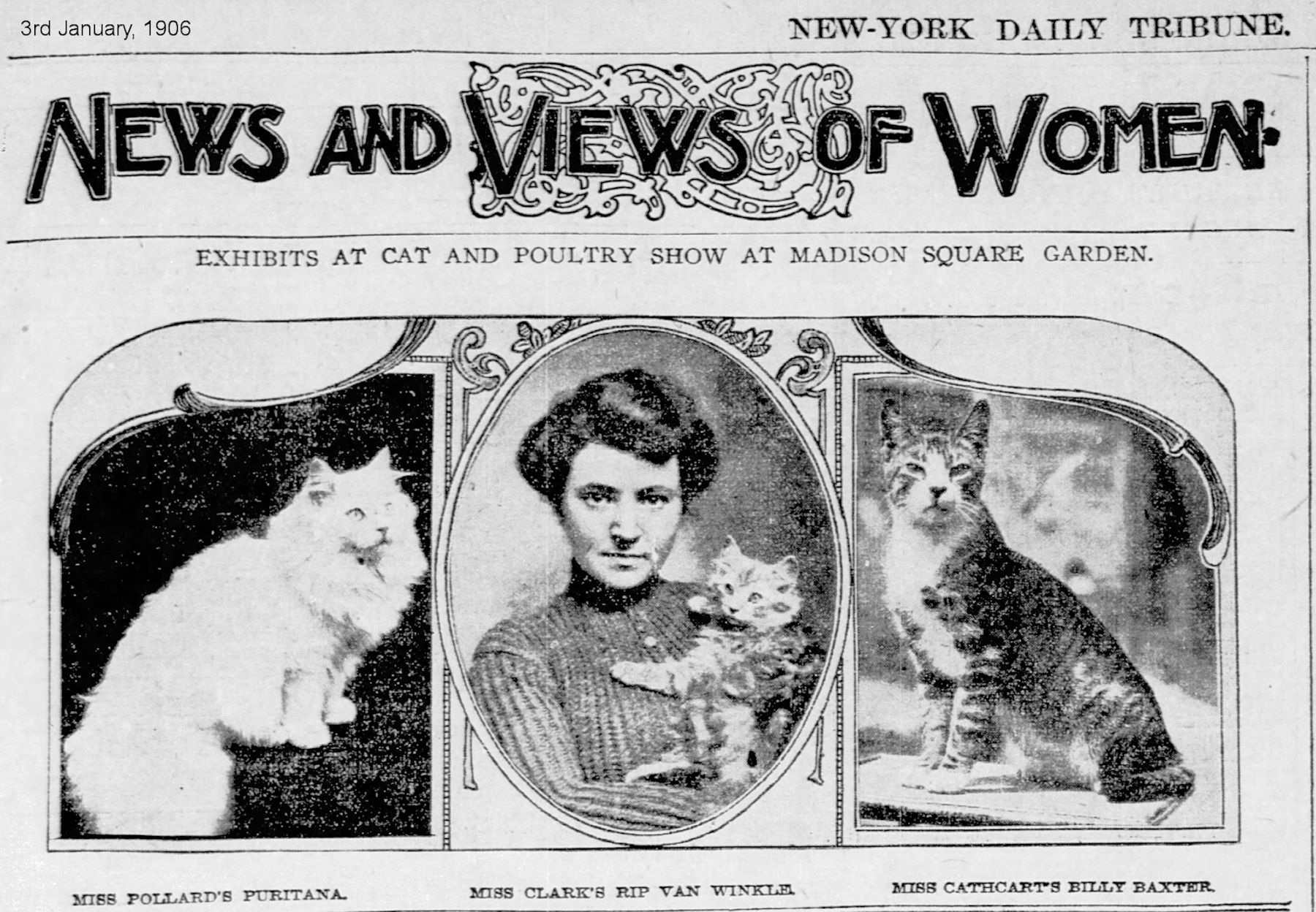
In 1906, Miss Cathcart was President of the newly formed national Short-haired Cat Society whose twin aims were to elevate the standard of short-haired cat's standard and prevent the existence of strays. The Society was affiliated with both the American Cat Association and the Cat Fanciers' Association. During a July 25, 1907 visit to Rochester, NY Miss Cathcart addressed the meeting, giving a talk on "raising the standard of short-haired cats by care in their breeding." (Democrat and Chronicle, 25th August 1906). Mrs Elizabeth Brace, Rochester, N.Y., who kept and exhibited Cathcart's cats during the winter months was Secretary-Treasurer of the society.
In her own promotional booklets Cathcart expounded on her goal of breeding purebred short-haired cats: "It is generally supposed that the common cat is treacherous, stupid, and attached to places rather than to people. In England, however, where the Short Haired branch of the Cat Fancy was first developed, it was quickly discovered that on the contrary this cat needed only the ordinary amount of care and kind treatment to become affectionate, intelligent and surpassingly beautiful. So we purchased our foundation stock there, including Champion Belle of Bradford (Orange Tabby Male), Champion Prissy, and Champion Lady Ann (Black Females), at the not inconsiderable sum of 16 16s 0d each, with the result that our cats now compete favorably with the proudest Persians on the Bench."
DAY OF "SHORT HAIRS" New-York Daily Tribune, 3rd January, 1906.
Short hairs are to play a prominent role in the little feline drama which opens at the poultry show in Madison Square Garden this morning . . . Miss Jane Cathcart offers a jewelled cat collar for the best Siamese male, and there are a souvenir spoon, several more medals, etc. Miss Jane Cathcart, whose cattery is devoted to the production of black short haired neuters, is not only a newcomer among the exhibitors at the Atlantic Cat Club show, but she will be one of the most important of the exhibitors of short hairs this week. Miss Cathcart is a firm believer in the short haired neuter as the most desirable of pet cats. She has had an automobile especially constructed for accommodation of her show cats. Among those which she will have on exhibition at the Garden are Jumbo, a blue; Prissy, a famous black female, bred by Hugh Maxwell, of England; Buster Brown, a native smoky male, and a great prize-winner, and Belle of Bradford, an orange tabby.
BLACK CAT REBELS IN THE GARDEN SHOW The New York Times, 4th January, 1906.
The annual cat show, held in conjunction with the poultry show, opened in the Concert Hall of Madison Square Garden. [. . .] A new exhibitor this year is Miss Jane Cathcart of Oradell. N. J., who has on exhibition three imported cats, all of which succeeded in securing the coveted blue ribbons. The cages in which the cats are shown have been tastefully and elaborately decorated, and the occupants are regally taken care of.
Irene Powell wrote about Miss Cathcart in The Cat Journal, July 1911. "There were Shorthairs in those days but nearly all were, as they were termed 'native' Shorthairs, Miss J.R. Cathcart, called the Fairy Godmother of the Shorthairs, was the greatest promoter of this breed and had some great winners. Ch. Buster Brown, Smoke, and Ch. Imp. Bell of Bradford, Red Tabby, were two of the prominent ones. Miss Cathcart brought other shorthairs from Europe: Moumouette, a Blue Cream, and two Blue Russians from France. However, in 1904 Mrs. Champion wrote that the Blue Shorthair has caused a great deal of discussion in England where it was first exhibited under the title Blue Russian. It was eventually decided to classify all blues as Blue Shorthairs and discard the name Russian, as these latter became too scarce to have a class to themselves. The two female 'Blue Russians' were sent to England to be bred to Peter the Great and Prince of Bath. Miss Cathcart later brought those two females to America where they became mates to Peterkin, a Blue Russian already abiding here and owned by Mrs. Sage. . . . Such was the extent of the recognized breeds of Shorthairs in the early part of the century. Fanciers have caused an evolution of the purebred cat that would cause the old time breeder to look on in amazement, and I am sure the end is not in sight yet."
FANCIERS FORM A NEW SOCIETY TO RAISE STANDARD OF THE SHORT-HAIRED CAT. NATIONAL ORGANIZATION PLANNED Democrat and Chronicle, 25th August 1906
Persons in All Parts of the United States Express Interest. To Promote Anti-Stray-Cat Project - Miss Cathcart President.
An organization that bids fair to be a National association and was formed to be such, has been started in this city by ten persons. It is called the Short-Haired Cat Society of America. The officers are: President, Miss Jane R. Cathcart, of Oradell, N. J.; vice-president, Mrs. Mary S, Sage, lecturer for the Humane Society; secretary and treasurer, Msa. Elizabeth L. Brace, assistant editor of the Cat Journal. The Executive Board is to consist of the officers and ten directors. The directors will all be persons of other cities.
To raise the standard of the short haired cat and to promote all that pertains to its welfare is the object of the society. The members hope to form branches in all parts of the country for the purpose of carrying forward the movement to eliminate the stray cat. This was suggested more than a year ago by the president of the new society, Miss Cathcart, who conducts the only exclusively short-haired cattery in America. The project has been heartily approved by the Lockehaven Cat Club, whose attorney is now working on a bill providing for limiting the ownership of male cats to breeders - the method Miss Cathcart proposed.
Miss Cathcart and Mrs. Brace are the only persons in this country, it is said, who breed only short-haired cats. Many other fanciers are breeders of both long-haired and short-haired cats, keeping them separate and the breeds of each exclusive. Miss Cathcart has raised the best smoke short-haired cats yet produced in the country, Mrs. Sage the best blue female and Mrs. J. See Bain, of North Chatam, the best blue male.
The society will be affiliated with both the American Cat Association and the Cat Fanciers' Association. The reason for this is that persons who have expressed a willingness to join the new organization are scattered in all parts of the country. Those of the Middle West and of the Far West would naturally prefer to exhibit in the shows of the American Cat Association. Two hundred persons have written to Mrs. Brace of late, saying that when a short-haired cat society should be formed they would like to be members. The organization will probably become a national affair in a short time. Most of the letters were written in response to a query in the Cat Journal, regarding the proposed society.
The charter members, besides the officers, are: Mrs. Alfred Jackson, president of the Lockehaven Club; C. H. Jones, editor of the Cat Journal, and Mrs. W. C. Russell, all of Rochester; Mrs. J. See Bain, of North Chatham; Miss Jennie Green, of Hubbardsville; Mrs. J, C. Mitchelson, of Tariffville, Conn., and Mrs. N. S. Stowell, of Hackensack, N. J. A constitution is being prepared. The organization's fanciers will exhibit in every show held by both the associations and will offer cups and medals at each show. Miss Cathcart has already offered a cup for the best short-haired blue male. Mrs. Bain has offered a cup and will later announce for what kind of cat. Four medals will be awarded at each show, for the best male, for the best female, the best kitten and the best neuter. The meetings will be held at the times of the shows, the only times they can take place, aa the members will be widely scattered.
MISS CATHCART ADDRESSES MEETING OF SHORT-HAIRED SOCIETY Democrat and Chronicler, 26th July 1907.
Members of the local chapter of the Short-Haired Cat Society were at the home of the regent, Mrs. Mary S. Sage, in Garson avenue, last night, to meet the national president, Miss Jane R. Cathcart. A number of visitors wag present. The meeting having been opened by Mrs. Sage and the usual reports read, Miss Cathcart gave a talk on raising the standard of short-haired cats by care in their breeding. She enlarged on the object of the organization, explaining its points the more fully because of the outsiders present. This society has the two-fold object of elevating the short-haired cat's standard and preventing the existence of strays.
The society seeks to weed out stray felines by creating a public sentiment that shall have such a result. It doesn't care for the showing of cats, particularly, but it conducts shows for the purpose of cultivating an appreciation of common cats. Directly a money or prize-winning value is attached to a cat, it argues, children and some grown people, as well, are apt to give it better care. The organization hopes ultimately to limit the male ownership of cats [Note - should be "the ownership of male cats"]. After the meeting, Miss Cathcart left this city for her home in Oradell, N. J. Refreshments were served by the hostess.
A CAT IMPORTER
She apparently brought back Champion Siam de Paris from her first trip to Europe. Siamese cats were a luxury cat in France, but she lamented that no-one seemed to maintain their pedigrees. Siam de Paris was a popular exhibit and often used in her publicity material. When he was sold for $475, the buyer wished to remain anonymous.
The first Shorthair registered in the Cat Fanciers' Association (CFA) was Ch. Belle Of Bradford (Imp), a British-bred orange tabby male imported and owned by Miss Jane Cathcart of New Jersey. Miss Cathcart claimed Belle had been pronounced almost unbeatable in his class at a Toronto Exhibition. During his nine-year show career in the USA, he was defeated only once by another orange tabby.
BEST BRED CATS ARE IN ENGLAND DECLARES MISS JANE R. CATHCART TO CAT CLUB. UNCLE SAM NOW RECOGNIZES THEM Democrat and Chronicle, 25th July 1907.
Cats Registered in England Pass Custom-House Officials Free of Duty - Lockehaven Club Members Entertained by Mrs. E.L. Brace.
A number of women, members of the Lockehaven Cat Club, who were guests of Mrs. Elizabeth L. Brace, yesterday afternoon, learned the cat news from France and England, from Miss Jane R. Cathcart, of Oradell, N. J., whom they had been invited to meet. Miss Cathcart, who has recently returned from a stay of many months in Europe, is the woman who suggested the plan to exterminate the stray cat, which clubs in various parts of the country are gradually trying to put in operation - the limitation of ownership of either males or females to breeds. She is not a stranger to most of the Lockehaven members, as she has met with them before and is a director of the club.
Miss Cathcart says that when shipping cats from England to this country, which she often does, she has arrangements by which they are boarded for two days at Southampton before the vessels sail, and two days more after the steamers have landed in New York. Miss Cathcart has one of her homes in Paris, just within the city's limits, close by the gates of the fortifications, and where she has a small garden. There is a place for the cats in connection with her stable. Going abroad as much as she does has caused fanciers in America to persuade her to buy cats for them in England. It is not as a means of livelihood that Miss Cathcart has come to do this. for she is a woman of abundant means, but, owing to her ability to judge of the feline beauties, it has fallen to her to select them for persons on this side of the water.
There are better cats in England than in America, perhaps, for the reason that they have been carefully bred there for more years. They have long ancestries and. therefore, are more valuable for breeders and for show cars. American cats, however, are rapidly gaining in quality. Miss Cathcart was speaking yesterday of the fact that registration of cats in England is now recognized by the United States government to such an extent that a cat that has been registered according to the rules of the National Cat Club of England is not liable to duty when it arrives at the Custom House on this side. The time was not long ago. when an English pussy's grandparents had to be recorded back to the fifth generation before she could be passed b y the officials without her owners paying duty. About a year ago a change in the regulations was made, so that when the proper papers are shown, registration there entitles, the cats to be registered here. This is because Uncle Sam takes precautions that duty shall be levied on cats not calculated to improve the breeds in this country. The club mentioned above sets the standard for England.
Some of the Royalty of England and many persons of the nobility are interested in the careful breeding of cats, Miss Cathcart says. Lady Marcus Beres[ford] is responsible for the fancy there, she says, and Louis Wain, the artist, successful as a painter of cats, is a friend of the fancy. English people interested in cats have specialist clubs and organizations there, as much as do the Americans. There are no fanciers in France, Miss Cathcart says.
"In France you don't see much but Siamese cats in the way of fancy breeds, says she. "They are a luxury and are not allowed to run about the streets, but their pedigrees are not kept. No one ever thinks of such a thing. You can get the French Angora, but this is generally a half breed. The French people are fond of pets and so are the friends of cats."
When Miss Cathcart came from France the last time she brought with her or shipped a silver tabby male, short-haired cat from Mrs. Collingwood's cattery. He is of the James II strain, the best for silver tabbies in England. She will soon have a black cat with orange eyes, which is to arrive at her home in Oradell. Miss Cathcart expects to start for there to-night.
The Rochester Chapter of the Short-Haired Society will meet at the home of the president, Mrs. Mary S. Sage, No. 379 Garson avenue, this evening. Miss Cathcart is president of the national society. Miss Cathcart is the guest while in this city of Mrs. Brace, where the Lockehaven members were entertained yesterday afternoon.
Cathcart always imported the best cats she could find and bred these imports with her own bloodlines. She specialised in the Shorthair breed and imported top-notch stock from British breeders into the USA. These were often bred with carefully selected local farm bloodlines and they contributed to the development of what is now known as the American Shorthair. An indication of her success is shown by her American-bred white male, Champion Kombo. He won "Best Shorthair" at the 1909 Hartford show, and his sire, Jumbo, was undefeated in the blue colour class during his two-year show career.
She also imported the first blue-cream Shorthair, Moumouette, daughter of a French blue-cream named Bebe Bleue who was bred to English Champion Ballochmyle Brother Bump in England. Moumouette won prizes in many shows in the "Any Other Colour" class, and was bred to Champion Belle of Bradford, resulting in blue-cream "Missy" and tortoiseshell "Mixte."
In addition to the British and "native" shorthairs, she had Siamese, Russian and Abyssinian cats. In 1909, Cathcart imported the earliest Abyssinians in America. These were cats bred by Mrs Carew-Cox in Britain and were the littermates male Aluminium II (silver) and female Brunette, and another pair of littermates called male Pepper (silver) and female Salt. In 1916 she imported and registered male Gondar and female Tit-Bits, both silver Abyssinians. All of these cats were sired by Aluminium I. They were all registered with the American Cat Association, but were rarely exhibited. Aluminum II and Salt were exhibited - and won - at the Madison Square Garden show in 1909. It is not recorded whether Cathcart planned to breed Abyssinians breeding program, possibly for silver Abyssinians, as there are no recorded offspring from any of these imports.
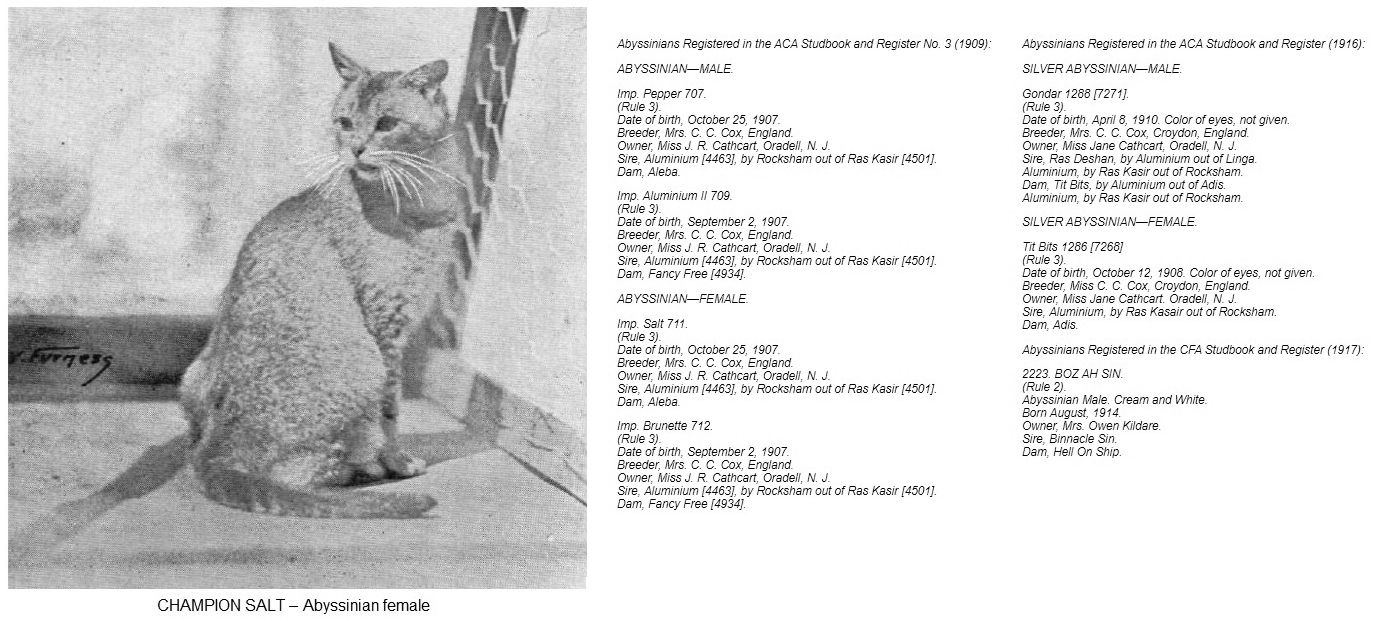
Irene Powell' article about Miss Cathcart The Cat Journal, July 1911 mentions the importation of Abyssinians, Manx, Siamese and Chocolates. The latter were either solid brown versions of the Siamese or had the brown Burmese pattern.
The Black Short Haired Cattery sold kittens of several shorthaired breeds: English Shorthairs, Manx, Maltese (Blue Shorthairs), Russian Blues and Siamese. However she remains most famous for her (American) Shorthairs, especially Black Shorthairs. It was also a successful boarding facility for cats, dogs and birds. It also took in female cats for mating to Cathcart's numerous Shorthair studs, or to "other good studs, never exhibited" at a cheaper rate. In addition to stud services, Cathcart sold cat accessories such as collars, bells, leads and harnesses, indicating that she was a serious businesswoman, not just a hobbyist breeder.
A BUSY LIFE
Miss Cathcart was so busy that she rarely exhibited the cats herself. She had a home and small garden in Paris, just within the city's limits, close by the gates of the fortifications. Up until the First World War she spent six months over the winter period in Paris, attending to her affairs there (whether business or romantic isn't known). She also visited England during those winter months and often returned to the USA with quality cats from British breeders such as Mrs Collingwood and Mrs Carew Cox. Mrs. Elizabeth Brace of Rochester, New York, exhibited Cathcart's cats.
"Mrs. Brace was the corresponding secretary [of the Lockehaven Cat Club] and declined renomination for that office before she was elected vice-president. She resigned because her time is largely taken up with the Rochester Branch of Miss Jane R. Cathcart's black short-haired cattery, and because of the trips she makes to show the cats in different cities where exhibitions are held . . . Mrs. Brace left last night for Boston, to attend the show of the Boston club. From there she will go to Columbus, O., and thence to Chicago. In shows to be held by the clubs of these cities she has entered twelve of Miss Cathcart's cats and two of her own" (Democrat and Chronicle, 12th January 1910 )
GREAT CAT SHOW WILL BE HELD HERE IN DECEMBER. The Buffalo Enquirer, 12th November 1906
Miss Jane R. Cathcart of Oradell, N.J., enters twenty-one cats, all short-haired. In about one month Miss Cathcart will go to Paris to remain all winter, probably until June. Mrs. Brace, who has recently been to visit her, will have charge of the exhibiting of all Miss Cathcart's show cats in her absence. The twenty-one on the list for Buffalo are the cats that will probably be shown all the season, provided their health remains good. The expenses of showing these pets will be not less than $600 or $700. Their entrance fees alone in the exhibition amount to $21. Mrs. Brace will go with them to all the cities where they are shown.
DISTINGUISHED CATS ARE COMING TO TOWN. About Fifteen Are Expected for the Winter - Democrat and Chronicle, 2nd November 1908
Possibly the most distinguished group of cats that ever came to Rochester will arrive on Thursday from Oradell, N.J. For several years Mrs. Elizabeth L. Brace, secretary of Lockehaven Cat Club has had charge of the showing of Miss Jane R. Cathcart's cats, and this season she will keep them with her in Rochester when they are not on exhibition. About fifteen are expected. Among them will be the pair of great English silver tabbies, Champion Silver Stripes and Champion Dame Fortune II., parents of Genesee Valley Jane, owned by Mrs. Brace. Genesee Valley Jane was the best kitten" in the Connecticut Club show held in Hartford last spring. She won over all the long-haired kittens. This was the first case in which a short-haired kitten in this country had been best In the show. The judges said she was the most perfect specimen they had ever seen.
A pair of Abyssinian cats, the only ones in America, will come. Three Russian females and the only Russian male in this country are booked for the trip. The male is Peterkin, owned by Mrs. Mary S. Sage, of this city, although he has been kept at the Oradell cattery this season, There will als be sent two Siamese males and a pair of white cats with blue eyes. All but one of the pets were imported and their average worth in money is said to be $100.
Mrs. Brace and Mrs. Sage returned a short time ago from Oradell, where they attended a large reception given by Miss Cathcart, at the cattery. Mrs. Sage spoke on 'The Short-haired Cat Society of America."' She is vice-president of the national organization and regent of the Rochester chapter. The short-haired cat is growing In popularity and fanciers say that many former breeders of the long haired pussies are now raising short-haired ones.
CATS WHICH LIVE BETTER LIVES THAN HUMANS. ROCHESTER WOMAN HAS A CATTERY IN WHICH THE FELINES ARE WATCHED BY SERVANTS AND SLEEP ON SILK AND VELVET CUSHIONS. The Buffalo Enquirer, 23rd November 1908.
Mrs. Elizabeth L Brace is establishing a cattery at her home, No. 437 Frost Avenue, and many of its occupants are famous. Their pedigrees are long, while in most cases their hair is short. As told some days ago, fifteen of these cats come from the Black Short-haired Cattery at Oradell, N. J., owned by Miss Jane R. Cathcart. Mrs. Brace will care for the pets this winter and take them to all the shows where they will be entered.
When the cats were sent here they were prepared for the trip in proper fashion. It would be interesting to one not familiar with the fancy to see how these pets are equipped for journeys. They travel in Backus cages, which all thoroughbred cats regard as the Pullman cars for cat travelers. Each cage is about eighteen by twenty-four inches and about twenty inches high. There is a buffet In the side, with places for food and water, while on the floor is velvet carpet. The cats travel in the same cages when they go to shows. The cage has a gable roof and on the top is a handle.
Every one of the Oradell cats was imported, with one exception, Kombo, a white male champion with blue eyes. His mate, Snowdrift, also white with blue eyes, is from England. Two of the valuable ones are Champion Silver Stripes and his mate, Dame Fortune II. Both are silver tabbies. Silver Stripe's former owner. Mrs. Collingwood, of England, has tried to buy him back at a greatly increased price. There are three Russian females, Chita, Sacha and Speedwell of Bath. A pair of Abyssinians of the cattery are the only ones in this country. The male is Aluminum II, and the female is Salt. They are of a silver shade, Then there are two Siamese males, Siam de Paris and Prince Damrong. Besides these is a brown tabby, called the Lady in Brown, which has never contested for honors, as she is to be shown for the first time this season.
Master Frank Decker, who was at Miss Cathcart's cattery through the summer, came with the cats to Rochester. He is well informed on catology and makes a valuable assistant to Mrs. Brace.
"Mrs. Elizabeth L. Brace, corresponding secretary of the Lockehaven Cat Club, will leave on Thursday for Oradell, N. J.. where she will attend a party to be given by Miss Jane R. Cathcart, owner of the Black Short-Haired Cattery, and a noted fancier of that place and Paris. After returning from her winter home in the suburbs of the French capital, Miss Cathcart every Year entertains fanciers in the vicinity of New York at her "spring party." Owners of cats left as "boarders" at the cattery are also invited." (Democrat and Chronicle, 24th May 1909)
Miss Cathcart's objectives were to provide a boarding place for pet cats where they could have, as far as possible, the 'comforts of home, including spacious quarters and ample opportunity for exercise. Her other objective was to breed high-class short-haired cats. As well as her own breeding programme, she accepted visiting queens for stud service. There were often over 100 cats at the cattery, many of them boarders. As time went on, the management of the Cattery itself became so involved that Cathcart took on a secretary, Mrs. Harriett V. Furness, who was a well-known photographer, artist and breeder of Persians (Buffalo Enquirer, 23rd November 1908). From 1914, she started to accept dog boarders as well, was selling puppies and advertising canine stud services. Only two years later she would run down the cattery and kennels completely.

Cathcart took out full-page adverts in The Cat Review until 1912, at which time she transferred her advertising to The Cat Courier, a journal started by her close friend and fellow Short-Haired Cat Society member, Mrs. Elizabeth Brace. Brace boarded and exhibited some of Cathcart's cats when the latter was living in Paris for 6 months of the year. Cathcart also advertised in newspapers at that time, for example:
FOR SALE - By the Black Short-Haired Cattery, Oradell, N. J., Persian kittens and five young Persian neuter cats; all colors; also male and female puppies of pedigreed stock, Boston Bull, Airedaie and cocker spaniels, of several colors; also Russian wolf hound, Yorkshire and Maltease poodles. At stud, fine Persian cats, chinchilla, orange or black; stud fee, $30. Short-haired studs of all colors, prize winners, fee $5; Bob-tailed stud, fee $5.00; Boston Bull, stud fee $15; Fine Russian Wolf hound, fully pedigreed, stud fee $25. Send for new catalogue and price list. Cats, dogs ang birds boarded. Expert Care. - The Record, 26th February 1914
LIFE AFTER THE BLACK SHORT-HAIRED CATTERY
The closure of the breeding cattery occurred during the First World War, when she would have been unable to travel to France to acquire cats, or to import cats from the UK and Europe. By 1916, the Black Short-Haired Cattery was no longer advertising. Cathcart moved on to horses on her home property in Hasbrouck Heights, establishing a stables and training track that became as much a local attraction as her Black Short-Haired Cattery.
The Binghamton Press 9th November, 1916 (Import Hackneys For National Show to Open in Garden on November 11) reported that Florham Squire, owned by Miss J.R. Cathcart, Hasbrouck Heights was entered. The Courier, 13th November 1916, reported "Exhibitors who lead in the number of their entries for the National Horse Show this year have estates in New Jersey or are permanent residents . . . A newcomer this year is Miss Jane R. Cathcart, of Hasbrouck Heights, who has entered the hackney stallion Florham Squire, bred by the late H. McK. Twombley." (Hamilton McKown Twombly, a prominent and well-connected capitalist whose hackneys were world famous.)
It seems quite a leap from cat-farming to horse-farming, but the American Hackney Horse had increased in popularity as a harness horse since 1884. Hackney stallions were bred to saddle-horses and trotters to produce carriage horses, and a prize-winning stallion could command good stud fees. When the Great War broke out in Europe, American horse breeders believed they could sell hackneys to England after the war to replace those requisitioned by the army. A good quality stallion seemed like a good investment. Unfortunately, motor cars and motor buses were replacing hackney carriages; horse-drawn traffic was being restricted in parts of some British towns because of the manure they produced. Ironically, newspapers carried adverts for motorcars on the horse show results pages, and in 1905, Cathcart had commissioned a special automobile for transporting her cats, but she didn't foresee how quickly motor vehicles would replace horses.
Her stallion, Florham Squire, came from excellent stock. It was foaled in 1906 at the Florham stud farm (Florham Hackney Stud), Madison, N.J. established by H. McK. Twombly who died in January 1910. George Watson, harness-horse dealer, took over the stud farm and its horses. Florham Squire then became the property of Mr A.M. Orr, possibly when Orr "purchased some of the best harness horses in sight" in spring 1912 (Detroit Free Press, 16th November 1913). Orr died in December 1913, and in March 1914 Florham Squire was bought back for $550 by George Watson when the stud and stable of the late A. M. Orr were sold off. According to Brooklyn Life (13th June, 1914), "the splendid hackney stallion" Florham Squire was owned by Mr M. M. Dimond of Paradise Farm, Teaneck, New Jersey. At the Red Cross Horse Show, New York, December 1914, Paradise Farm's Florham Squire was fourth in his class for Hackney stallions over 15.1 hands (Washington Post, 10th December 1934). It was at this event that "breeders seemed to be unanimous in the belief that after the war in Europe is over England may have to replenish her stock of hackneys by importing horses from this country. Mr. Vanderbilt read a letter from there lately received by him saying the military authorities were taking many hundreds of hackneys from the breeding studs and show stables."
During 1916 he was owned and exhibited by Miss Cathcart who probably thought carriage horse breeding would be profitable. By then, motorcars, rather than carriage horses, were the new status symbol for private owners, while motor vehicles overtook horse-drawn vehicles as public transport. Cathcart would probably have done better to invest in the emerging auto industry! She seems to have given up horse-breeding around 1918. By 1924, Florham Squire (gelded) was listed as the property of either Mortimer Fuller or C.M.O Boyle (reports from April 1924 Brooklyn Horse Show vary) and was entered in classes for ponies in harness.
In 1918, Cathcart began living with her close friend Ethel Grow, a contralto singer, and it was around this time that she gave up horses and seemed to direct all her energies into the Washington Heights Musical Club. There had been a club of that name in 1908 (The Brooklyn Citizen, 4th April 1908, Page 10), but no further mentions until 1922 when Cathcart is described as founder-president. Ethel Grow and Jane Cathcart were colleagues of Henry Holden Huss; he described them as an American art song singer and a piano teacher and founder of a musical club for young students respectively (letter from Huss to Elizabeth Sprague Coolidge, 8th September 1923).

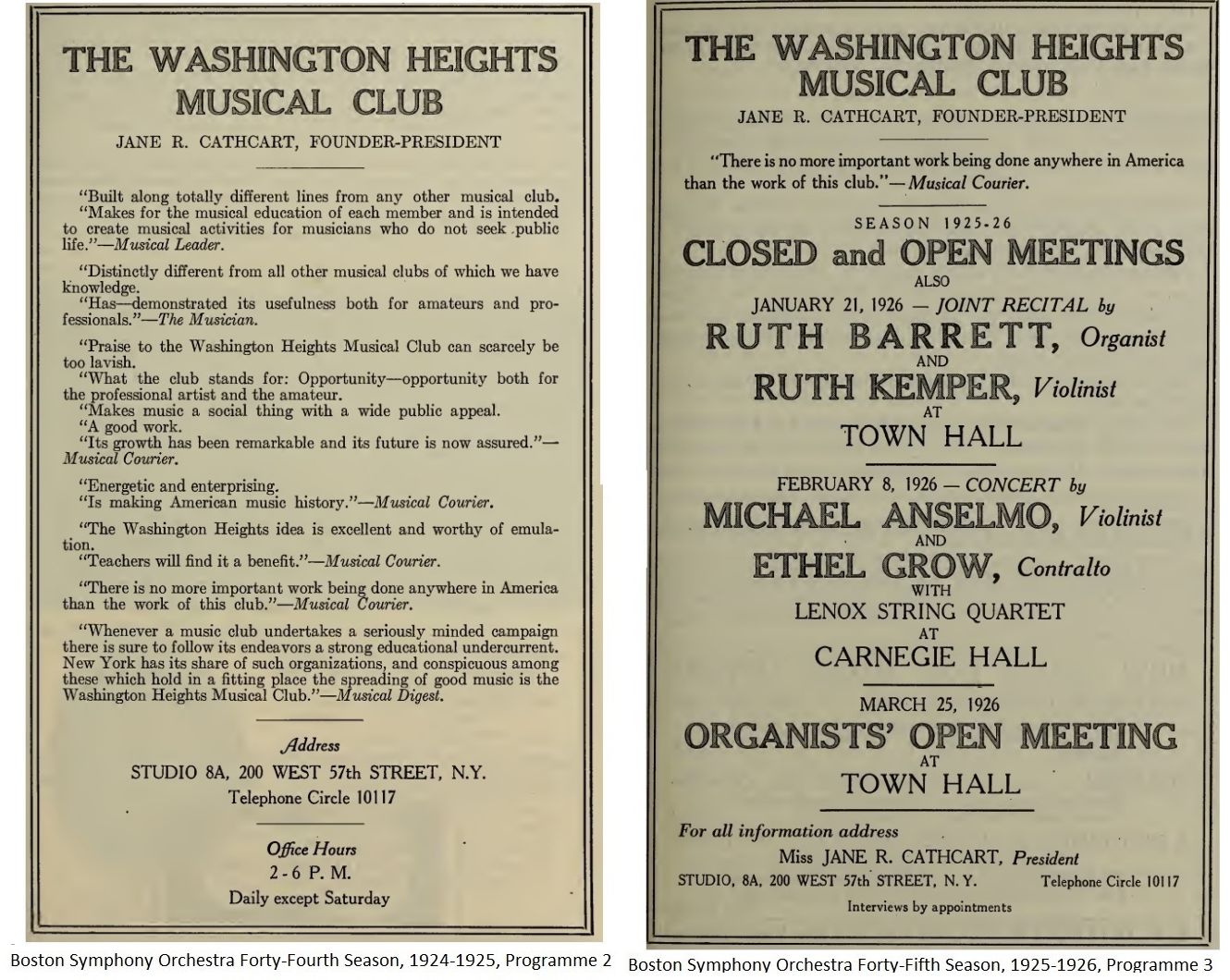
By the 1920s she was advertising her services in New York papers as a piano teacher, which suggests she needed other sources of income. She had previously divided her time between the USA and France and paid others to run her cattery, kennels and exhibit her cats. It seems she no longer had her previous source of income to finance her animal-related businesses/hobbies. Although a few animals could sell for high prices, on the whole the breeding business is not profitable. and between 1905 up to mid-1914 (France's entry into the First World War), she was paying others to run her businesses for half the year. She was "a woman of considerable wealth until World War 1." From 1923, she advertised in The Billboard as a piano teacher.
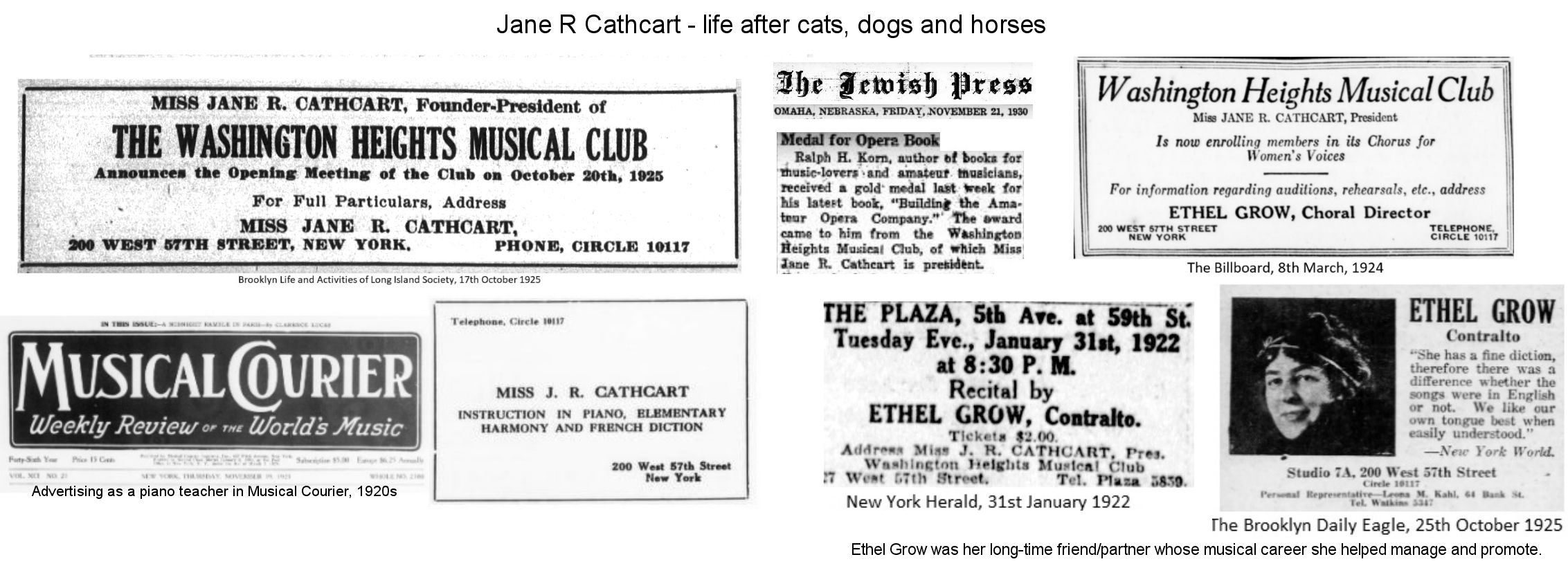
"Ethel Grow, contralto, and Jane R. Cathcart, founder and president of the Washington Heights Musical Club, have taken the C. Arthur Payne cottage in Southampton, L. I. for the summer. Among their guests is Carolyn Beebe, pianist and founder of the New York Chamber Music Society. Miss Beebe spends her week-ends in Southampton teaching a group of advanced students. Regina Kahl, soprano, is also at the Payne cottage, continuing her studies under Miss Grow." (Musicians Take Cottage in Southampton - Musical America, August 1, 1925, pg 23)
"Miss Jane R. Cathcart, Founder-President of the Washington Heights Musical Club entertained friends last Tuesday evening at her home, 200 West Fifty-seventh Street. " (Brooklyn Life and Activities of Long Island Society, 14th November 1925)
MISS CATHCART'S RESIGNATION - Musical Courier November 15, 1930 page 26
Surprise as well as regret will be caused by the resignation from the presidency and active membership of the Washington Heights Musical Club of Jane R. Cathcart. Miss Cathcart was chiefly instrumental in organizing this club and actually maintained it for several years. Two or three years ago Miss Cathcart felt that the club had had a fair trial and should be self-supporting, and she made a test in this direction which has proved satisfactory. Her resignation is now caused by the fact that she has found herself forced to move her residence out of New York.
The club seems to have grown less rapidly than one would have expected from the exceedingly practical ideas of its founders. One of those ideas was the encouragement of amateur playing and singing, a revival of old time ideas of musical "get together hours." A further idea was to give young artists opportunity for public performance under favorable auspices. It was the belief of many people who watched the club's beginnings that these ideas would find large popular appeal, and that the club would immediately grow to considerable membership and take an important place in New York music life. This, however, failed to materialize. Amateurs did not show themselves so terribly anxious to get together for small chamber music or orchestra performances, informal choral singing and so on, and club prospective members apparently did not appear any too anxious to hear young singers and instrumentalists perform in public. It appears also to have been a fact that certain professionals used the club for personal exploitation, and that, of course, did the club no good.
It is a great pity that the ideas that Miss Cathcart and Ethel Grow had at the beginning could not have been developed and strictly maintained. What we need more than anything else in this country just now is music making by the amateur. This has been brought to attention by no less a man than Harold Bauer himself, and has also been spoken of by Mrs. Thomas A. Edison and many other public thinking citizens who have the best interests of America at Just why the Washington Heights idea was not more successful than it was will perhaps always be a mystery. Perhaps one of the reasons is that Miss Cathcart's generous attitude was not reflected in the attitude of some others.
Miss Cathcart died in 1947: "Cathcart - At her home in Hasbrouck Heights, N.J. on April 30, 1947. Jane R. Cathcart of 324 Henry Street. Funeral service will be held at Hill and Steward Funeral Home, 74 Central Avenue, Hackensack, on Friday evening, May 2, at 8 o'clock. Interment, Woodlawn Cemetery, N.Y." (The Record, 2nd May 1947) She was 73 years old.
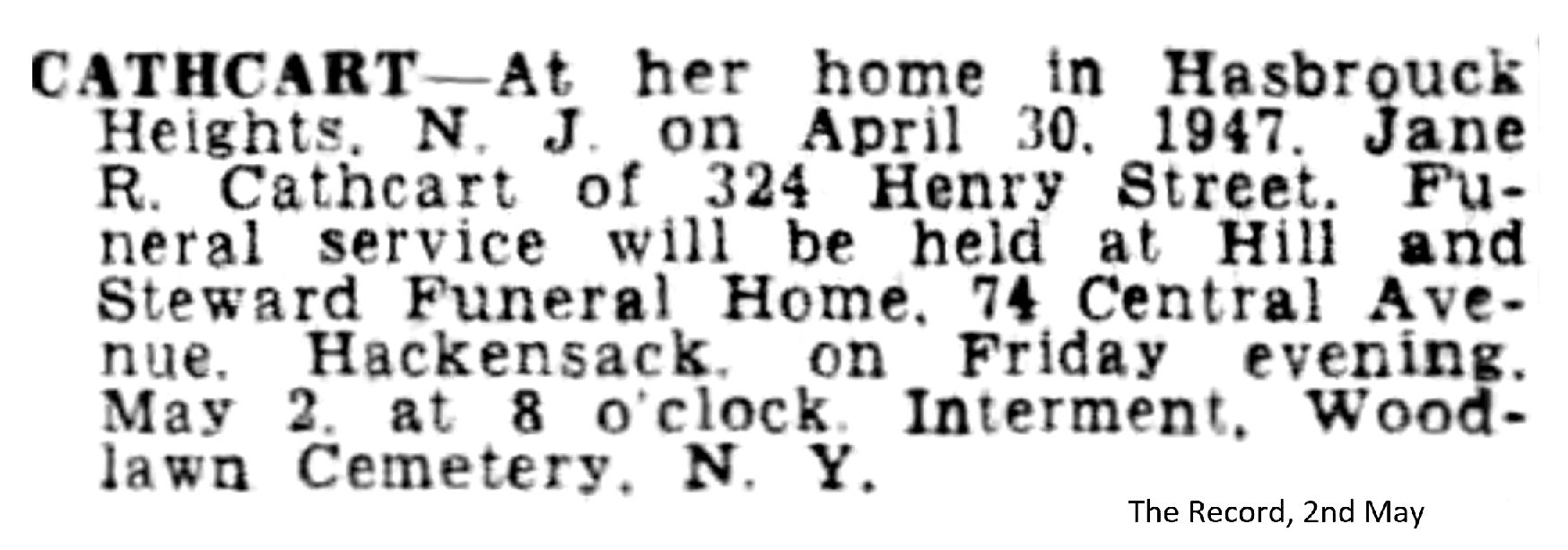
JANE CATHCART DIES IN HEIGHTS. Widely-Known Musician Gave Town Land - The Record, 2nd May 1947.
Jane R. Cathcart of 324 Henry Street, Hasbrouck Heights, a resident of the Borough since 1912 and a musician of note, died suddenly Wednesday morning at her home. Christian Science services will be conducted by Miss Elizabeth Bennet tonight at the Hill and Stewart Funeral Home. Interment will be in Woodlawn Cemetery where her parents, the late Mr. and Mrs. George R. Cathcart, are buried.
Music early became the cultural pursuit of Miss Cathcart. She Studied in Paris and New York City and composed many popular songs. For many years she was president of the Washington Heights Musical Club, which encouraged young artists. For 12 years Miss Cathcart spent six months of each year in Paris. Her father was an official of the American Book Company. A woman of considerable wealth until World War 1 she purchased the entire tract from Henry Street to Passaic, extending several hundred feet west of Terrace Avenue and established what for many years was the showplace of the community. Older residents recall the handsome stables, fine horses, and the training track built for them. The wall that still runs around the area where the Cathcart apartments now stands was daily lined with people watching the horses and the huge aviary in which birds from every part of the world were kept. Miss Cathcart had white wolfhounds [Borzois] as favorite pets.
Miss Cathcart gave to the town the property which made the Terrace Avenue curve at Henry Street. From her garden came several of the shrubs in Memorial Park which she had her gardener transplant just before the Park was dedicated in 1919. She leaves no relatives. Miss Cathcart lived with Ethel Grow, her close friend, for the past 29 years.
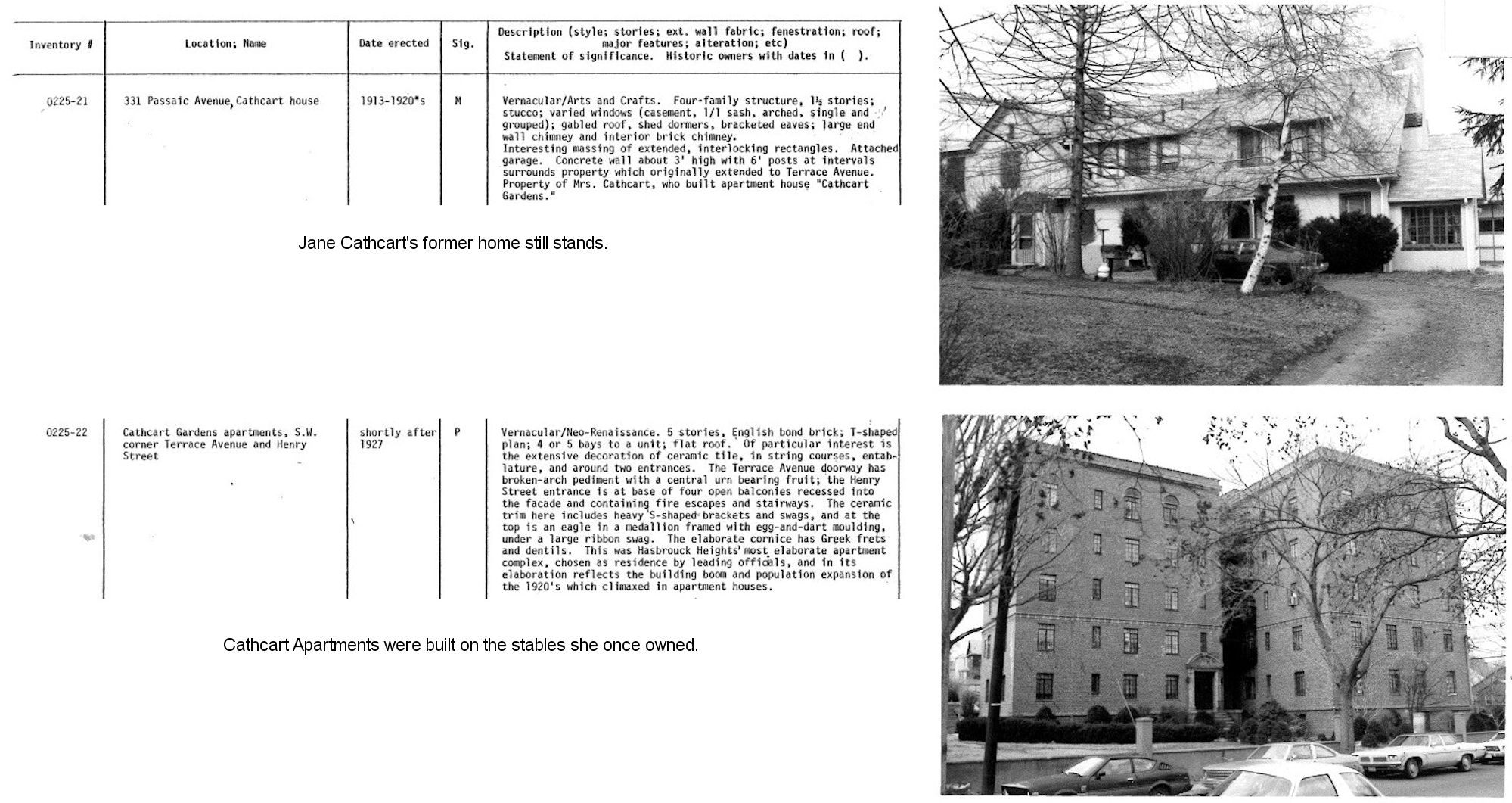
Her name is commemorated in the buildings in Hasbrouck Heights. Some of the properties built on her former stables were listed in the Bergen County Historic Sites Survey for the Borough of Hasbrouck Heights (1980 - 1981) where they illustrate the eclectic taste of the post World War I period (although her name was given as Mrs, rather than Miss).
The obituary makes no mention of her cattery and only a passing mention of an interest in dogs. It is as if that period in her life had never happened. Had she fallen out with her former cat fancy friends? Was it related to setting up home with Ethel Grow in 1918?
MISS CATHCART AS A PROPERTY DEVELOPER
Jane R Cathcart was also known as Jennie Cathcart (this may have been her legal name). It was under this name that she engaged in property development. The Evening Record and Bergen County Herald, Hackensack, 31st July 1906, recorded the transfer of 3 lots in the Borough of Hasbrouck Heights by Mr and Mrs Charles E. Cornell to Jennie R. Cathcart.
Then, in 1926 she decided to redevelop the land once occupied by her stables. "The outstanding event of the evening was a resolution unanimously passed by the Mavor and Council and signed by them, thanking Miss Jennie Cathcart for conveying by gift to the Borough of Hasbrouck Heights, a valuable parcel of land for the purpose of widening Old Terrace avenue, at Passaic avenue. Miss Cathcart was highly commended for her generous act, exemplifying the possession of civic pride to a high degree." (The Record, 11th September 1926). The Passaic Daily News and the Passaic Daily Herald, both 18th August 1928 recorded the approval of Jennie R. Cathcart s plans for a five storey brick building (a tenement) to be built at a cost of $200,000 on West Side of Terrace Avenue between Henry Street and Passaic Avenue.
ANNOUNCEMENT OF NEW APARTMENT CAUSES STIR - The Record, 21st August, 1928 Not for a long time has an announcement been made which has aroused such interest as the publication of the article on the proposed apartment house to be erected by Miss Jennie Cathcart on West Terrace avenue, adjoining Cathcart Garden and the two story apartment house, remodeled from a former building. The mayor stated last night in an informal conversation with the Evening Record representative that the architect of the $250,000 building to be started soon is Otto Getty, a former resident. It will accommodate fifty families. Building Inspector Broome has the plans at present. The apartment will be located on what is called old Terrace avenue, lying to the west of Memorial park, which separates old Terrace avenue from new Terrace avenue. According to a parking ordinance recently passed, it is a one way street, taking south bound traffic.
The second annual exhibit of the Garden Club of Hasbrouck Heights was held on September 25 and 26, Miss Cathcart's Estate, Hasbrouck Heights. (Annual Show of Hasbrouck Heights Garden Club Held. Passaic Daily News, 28th September, 1928)
PLAN 30 FAMILY APARTMENT HOUSE - Passaic Daily News, 21st December, 1928
The Cathcart Gardens Inc., recently incorporated, is completing plans for the erection, of a thirty family apartment house, at Henry Street and Terrace Avenue, Hasbrouck Heights. The building, which will be modern and up-to-date, will be erected at an approximate cost of $150,000. Miss Jennie R. Cathcart of New York City, who owns the property on which the apartment will go up, and who owns a majority of the stock, is president of the corporation. Other stockholders are Miss Ethel Grow, of New York; Will D. Martin and Horace F. Martin, of Hasbrouck Heights, and Otto J. Gette, of Bronxville, N.Y.
GARDEN APARTMENTS TO BE ERECTED IN HASBROUCK HEIGHTS - The Daily News. 5th February 1929
Building contract has been let to the firm of Eyrich & Ward Inc., of New York, for construction of Cathcart Gardens, a five story elevator garden apartment house, to be erected in Hasbrouck Heights by Miss Jennie R. Cathcart [ . . .] The new apartment house will be immediately opposite the Teterboro Flying Field, on Terrace Avenue.
AUXLIARY HAPPY OVER SELECTION OF CATHCART APARTMENTS: BUSY SESSION HELD BY MEMBERS - Passaic Daily Herald, 5th April, 1932
Announcement was made at yesterday's meeting of the Hasbrouck Heights Hospital Auxiliary [. . . ] The acquisition of the Cathcart Garden Apartments for the future home of the hospital was a source of congratulation and Supt. Harris Cohan received commendation from the Auxiliary on the successful negotiations, in securing the six-story apartment house on Terrace Avenue, overlooking the Palisades, with New York's skyscrapers visible In the distance during the day and myriads of electric lights lighting the eastern sky at night. A room on the first floor will be reserved for the auxiliary headquarters.
However, it was still residential apartment in 1942, judging by various news reports mentioning residents of the apartments. In 1937 the hospital association bought a property elsewhere on Terrace Avenue.
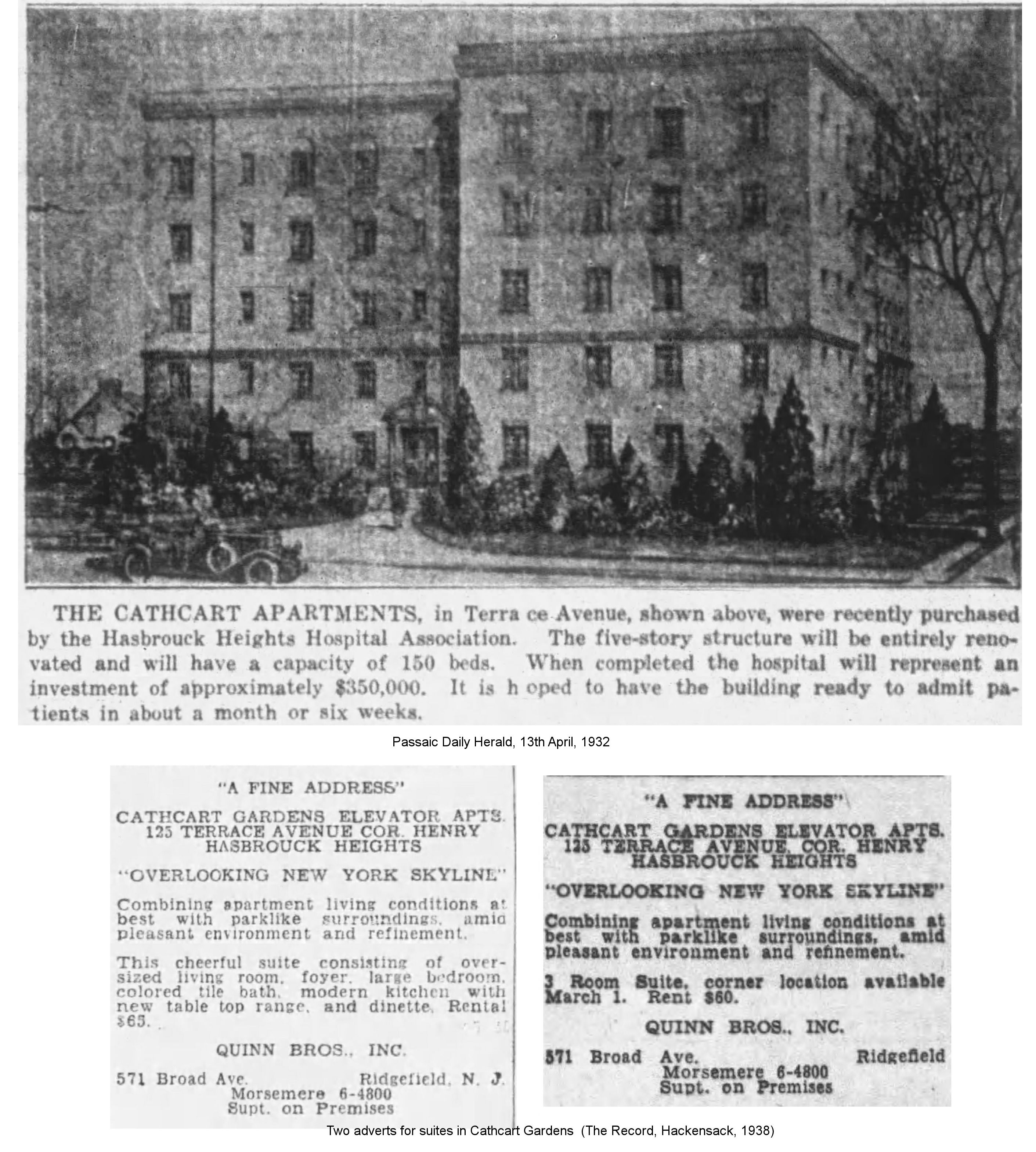
IN CHANCERY (COURT) OF NEW JERSEY - The Record, 6th April 1938 Between The Hasbrouck Heights Building Loan and Savings Association. a corporation of the State of New Jersey, complainant, and Jennie R. Cathcart, single, John Conaty, P. W. Wigginton, and William Henig, defendants. Fi. fa. Returnable, Jane 17th. A. D.. 1938. De Baun & Westervelt. Sol'rs By virtue of the above stated writ to me directed and delivered, I have levied upon and will expose for sale at public vendue at the Court House in the City of Hackensack, on Wednesday, April 20, 1938, at two o'clock in the afternoon. Standard Time. IN THE FIRST PLACE, one hundred thirty-four (134) shares of the capital stock of The Hasbrouck Heights Building Loan and Savings Association, a corporation of the State of New Jersey, assigned to said Association by Jennie R. Cathcart, as collateral security for the payment of the principal of the mortgage recorded in Book 1376 of Mortgages for the County of Bergen, page 348; and [lots 491 495, 515 519, except for 515 already conveyed to Alex Los and Wm. Imken. By Jennie R. Cathcart (unmarried) in August 1928] to be sold to pay and satisfy in the first place unto the said complainant, the sum of $35,070.80.
The Record (Hackensack), 15th November 1946 published a notice naming Persons appearing as owners of unclaimed amounts held by the Hackensack Trust Co. This listed Jennie R Cathcart, 200 W 57th Street, New York City. That was the year before her death.
SHOW-WINNING CATS
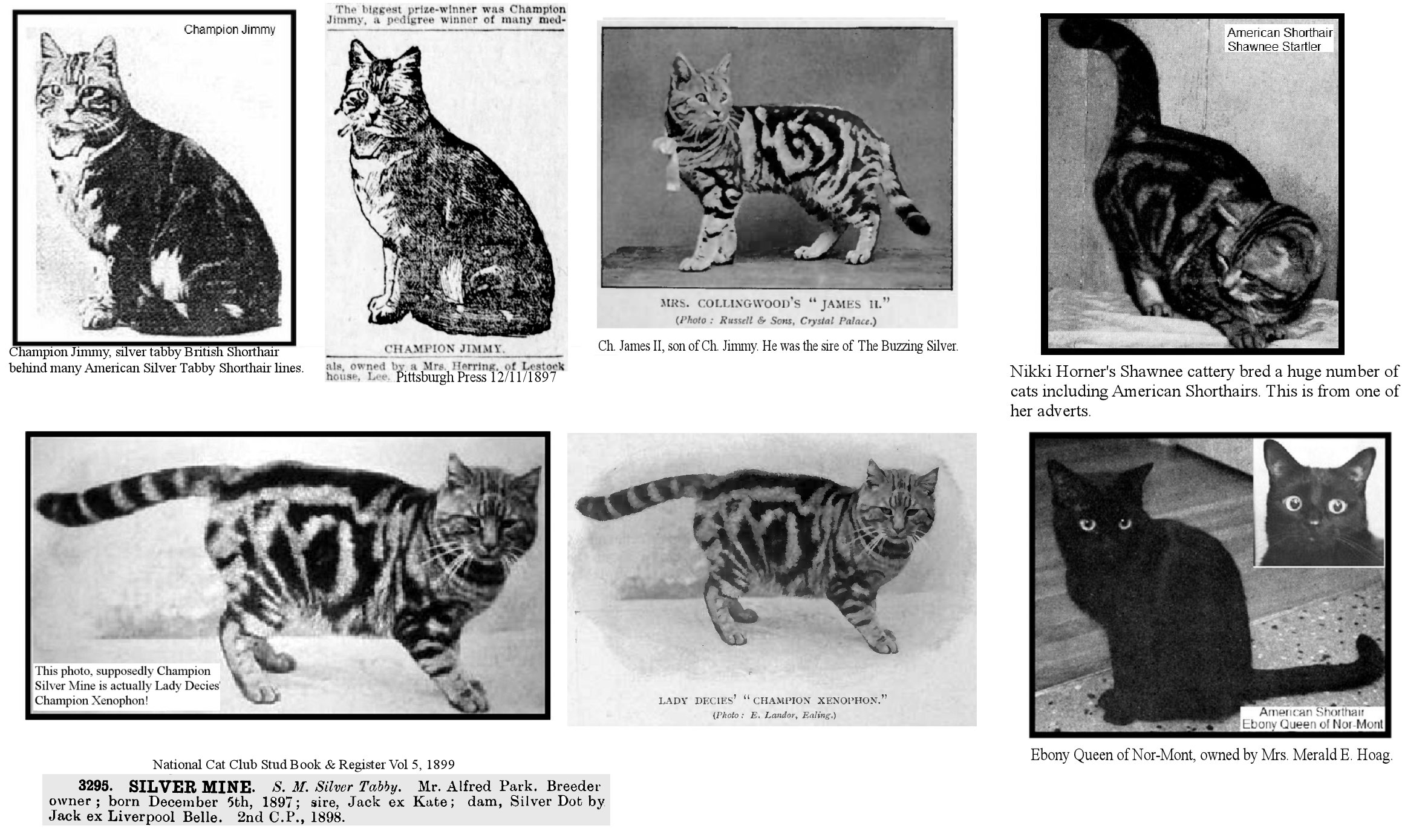
"Aristocratic cats began to arrive from all over the country yesterday for the national cat show which will be held by the Beresford [Cat] Club of America for three days, beginning tomorrow. The largest outside consignment will arrive today from Oradell, N.J., from the cattery of Miss J. Cathcart, who is shipping nineteen entries, in charge of their keeper, Johnnie Fawe. The famous long-haired black cat belonging to Dr. Otto Lenguie [sic], secretary of the Atlantic Cat Club of New York, will also arrive today." (The Inter Ocean, 15th January, 1906)
"Felines of All Kinds and Conditions to Be Here for Show in January. Michigan Cat Club Plans Big Contest [. . . ] Though the greater number of cats entered will undoubtedly be on the long-haired variety, there will also be an exhibition of short haired cats . . . short haired English cat is beginning to receive considerable attention at the hands of some cat fanciers, and Miss Jane Cathcart owns a kennel devoted exclusively to the breeding and improvement of this animal. Her cats are all registered, after the fashion of long hairs, and it is her aim to give them an equal standing. (Detroit Free Press, 12th November, 1906)
"This is Buster Brown . . . He is a champion short hair smoke and a native of America. Placed by the side of a black cat Buster's coat showed a tinge of plum color or dark cinder, though without the comparison the difference was scarcely noticeable. Unlike the black cat, however, his under fur is pure white, the hair shading gradually from white at the roots to black brown on the tips. This is the peculiarity of all smokes, which are extremely rare, and especially so in the short haired class. Buster is a champion of his kind and has been beaten only once and then by his wife Judy B., for whom Miss Cathcart paid $200. Judy B. lacks the handsome well shaped head of her mate but excels him in the fine quality of her coat and its even upper tone; also her tail is thinner. What the English call a whip tail is desired for a shorthaired cat, because a thick tail, breeders say, shows a long haired ancestor. (Elevating The Status Of Cats. Daily Arkansa Gazette, 4th November, 1906; New York Sun, 14th October, 1906, Miss Cathcart Runs an Interesting "Cattery" in New Jersey - Real Value is Apparent.)
Mrs. Brace took ten of Miss Jane R. Cathcart's cats to Chicago, as well as [Genesee Valley Jane], and they too got a fine lot of prizes. Those cats, with a number of others owned by Miss Cathcart of Oradell, N.J. are spending the winter at the home of Mrs. Brace. Eight the New Jersey short hairs won first prizes and the others were awarded seconds . . . On December 29th, a week from tomorrow, Mrs. Brace will go to New York for the show to be hold by the Atlantic Club on December 30th, 31st and January 1st. There she will again enter . . . three cats of Miss Cathcart's. (Democrat and Chronicle, 21st December 1908)
The twentieth annual exhibition of the New York Poultry, Pigeon and Pet Stock Association was opened at the Madison Square Garden yesterday morning [. . .] prominent exhibitors at this year's show will be Mrs. Champion and the Misses Champion, of West New Brighton, Staten Island; Miss J. Cathcart, of Oradell. N. J. (New York Tribune, 30th December, 1908)
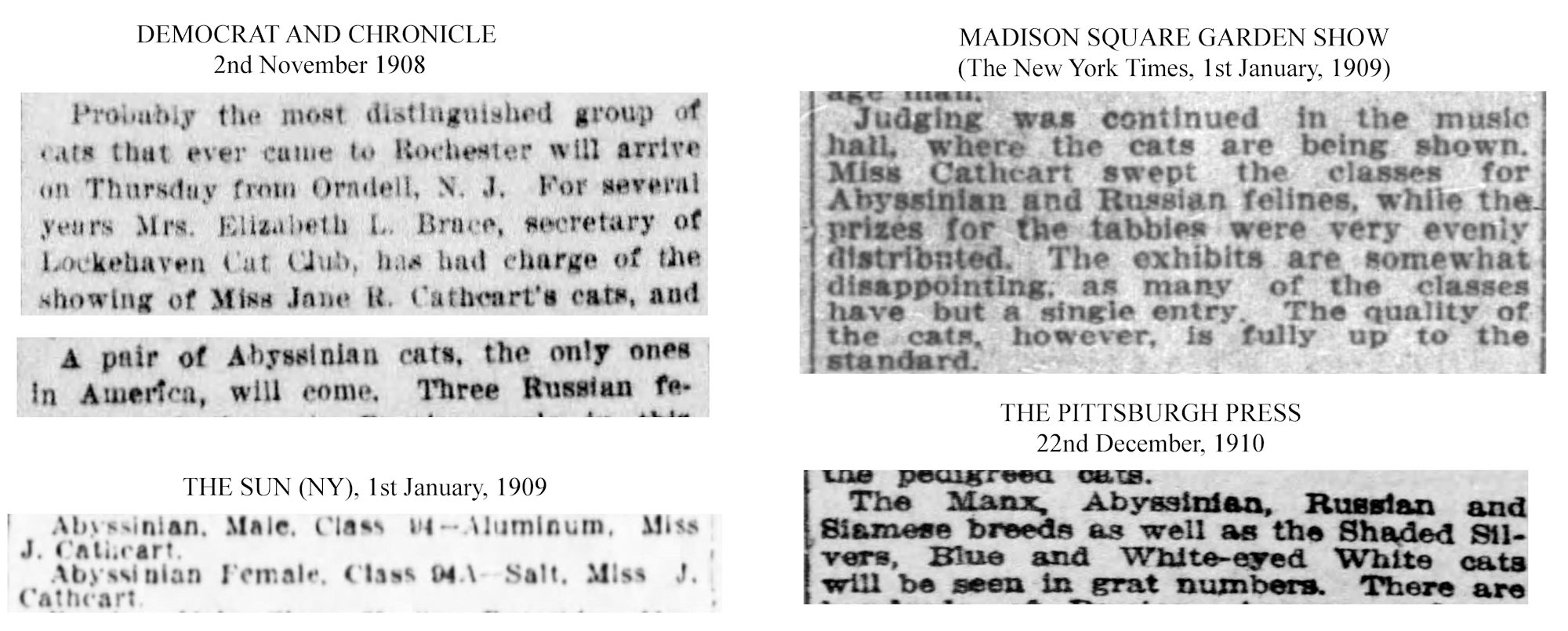
One of the foremost breeders of the shorts, Miss Jane Cathcart of Oradell, N J, exhibits several that were conspicuous among yesterday's winners. She took the blue for the best silver tabby male, the best Siamese male and female, the best Russian female, the best Abyssinian male and female, the best white with blue eyes and the best blue-eyed female. Miss Cathcart in an endeavor to elevate the standard of the short-hairs has been importing the best to be had in foreign lands. One of the best short-haired cats in the land was bred at the cattery conducted in Oradell, N J, by Miss Cathcart. It is a silver tabby named "Genesee Valley Jane," owned by Mrs Elizabeth Brace of Rochester, N Y. This elating pussy is only nine months old, and she is a champion. . . judges who have examined her say she comes as near to being the perfect cat as it is possible to breed. (The Boston Globe, 15th January 1909)
"All kinds of cats except the backyard variety, opened the first Pittsburg cat show at Old City Hall. Market street, this morning [. . . ] Among the first of the exhibitors to arrive was Mrs. E. L. Brace, with Miss Jane Cathcart's famous Royal Siamese cats. They were brought from Oradell, N.J." (The Pittsburgh Press, 30th November, 1909)
Mrs. Elizabeth L. Brace, who returned on Saturday from the Boston Cat Club's show, will leave to-night for Grand Rapids, Michigan, where she will take fifteen of Miss Jane R. Cathcart's cats and some of her own, to exhibit in the Michigan Club show on Wednesday, Thursday and Friday. . . . Mrs. Brace took to Boston The Duchess, a Siamese cat that Miss Cathcart recently imported from Siam at large expense. This pretty creature is so valuable and tender that Mrs. Brace took her in a cage with Genesee Valley Jane, made for carrying by hand. In this they went in the Pullman cars. They scarcely made a murmur while on the trains. The Duchess, who came to Rochester about January 1st, is a fawn color with ears, tail, legs and mask of seal brown. Her eyes are blue. (Democrat and Chronicle, 18th January, 1909)
Poultry and cats again divided attention yesterday at Madison Square Garden, when the biggest Thursday crowd in the history of the poultry show was in attendance. Outside of the judging there was very little to interest the spectator, [. . .] Judging was continued in the music hall where the cats are being shown. Miss Cathcart swept the classes for Abyssinian and Russian felines. (The New York Times, 1st January 1909) (The following were the classes Cathcart won: Siamese, Male, Class 90 - Ch. Siam de Paris. Siamese, Female, Class 91 - First, Siamese Female. Abyssinian, Male, Class 94 - Aluminium. Abyssinian, Female, Class 94A - Salt. Russian, Female, Class 96 - First, Sacha; second, Speedwell.
"Cats of high degree, with proud and haughty manners, are benched at the ninth championship cat show of the Atlantic Cat Club -in the concert hall of Madison Square Garden in conjunction with the poultry show . . . Champion Siam de Paris is the finest type of Siamese cat and is owned by Miss Jane Cathcart or Oradell, N.J." (Evening Star, 30th December, 1910)